|
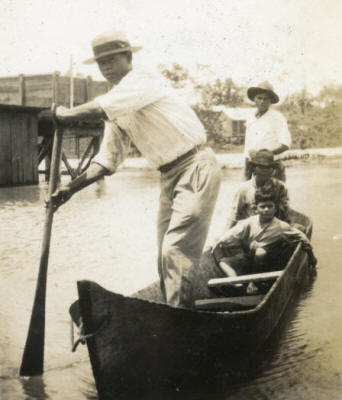 THIS IS THE FIRST PAGE OF
DOCUMENTS FOR THE SECOND HALF OF 1932
on Nicaragua's Caribbean Coast region, housing
documents dated during the 92 days from July 1 to
September 30.
THIS IS THE FIRST PAGE OF
DOCUMENTS FOR THE SECOND HALF OF 1932
on Nicaragua's Caribbean Coast region, housing
documents dated during the 92 days from July 1 to
September 30.
After getting hammered in late May
in the mining districts by a
relentlessly aggressive Guardia
counteroffensive, the rebel columns
under Generals Pedrón & Irías
withdraw south, surfacing about a
month later at the upper reaches of
the Río Tuma. We learn the
extent of their defeat in several
revealing eyewitness accounts, most
notably by Nicolás Gómez (1 July).
Meantime things are heating up
around Puerto Cabezas, with
a major EDSN offensive into the
banana zone just northwest of the
city led by Generals Simón González
& Francisco Estrada. Crossing
overland south from the villages of
Sacklin & Cum on the Río Coco, the
rebels sack the Vaccaro Farm
Commissary on July 5, killing the
British supervisor H. L. Cooke
(according to a report of 17 August,
facilitated as an act of vengeance
by a disgruntled employee), and the
next day are driven back by yet
another aggressive Guardia
counteroffensive that combines
several ground patrols with a series
of deadly air attacks (reports of 11
July, 1 & 9 August). On a side
note, Area Commander Leech seems
irritated by Lt. Gaitán’s
lackadaisical response to the rebel
offensive and disinclined to approve
his request for a transfer from the
Eastern Area (11 July), though
Gaitán’s arduous weeklong patrol
from Puerto Cabezas to the Río Coco
& back might have redeemed him in
Leech’s eyes (24 July).
Further south, Pedrón & Irías’s
reconstituted forces resurface
along the middle stretches of the
Río Grande de Matagalpa (into which
flows the Río Tuma). On July
17, some 50 rebels under Pedrón and
several lesser jefes sack at least
two commissaries near La Cruz, just
downriver from El Gallo (Morazón
Farm and the Pan American), killing
Morazón’s manager Santiago Schech
and three Hislop brothers (Clayton,
Albert & Willie; a fourth brother,
Ed Hislop, who owns the Pan
American, flees to Bluefields with
news of the rebels’ approach; see ).
Pedrón is accompanied by a new jefe,
one Chavalía of La Cruz (first name
unknown), who follows a now familiar
pattern, settling an old grudge
against Ed Hislop by slaughtering
three of his brothers. On July
15, General Irías informs Sandino
that his forces have “chalequeado”
(butchered with machetes) 15
“traitors” on this expedition,
collaborators with the Marines &
Guardia, and naming most of them
(letter included in Somoza excerpt,
listed under 15 July). Adding
to the grisly total are the men
listed by Col. Leech (23 August).
Sandinista spectacular violence, a
phenomenon of Western Nicaragua (and
more specifically in this case Las
Segovias) intended to produce fear
of disloyalty among witnesses &
survivors — to create a cultural
sensibility infused with fear &
terror — instead seems to have
alienated large numbers Costeños
from Sandino's nationalist cause, a
cultural dynamic explored by David
C. Brooks (1997).
Significantly,
despite high unemployment and
general economic malaise,
one detects in the Guardia’s various
reports little concern about local
people joining up with the advancing
rebels. Even Western Nicaraguan
Spanish-speaking wage laborers on
the farms & plantations near
Vaccaro, El Gallo, & elsewhere do
not seem keen to link up with the
rebel offensive. At least there are
no such reports, and there surely
would be were it a perceived
counterinsurgency problem. Moravian
missionaries offer their own take on
events even as they continue to
lament the violence & disruptions
caused by the rebel offensive (6 &
15 & 20 July). Meantime a
fascinating spy report by one Agent
#38 offers a revealing glimpse into
the world of communist organizing in
Bluefields (7 September).
The
overall portrait here is
consonant with that of previous
pages: a series of tenacious rebel
offensives into the Coast, as before
accompanied by extensive spectacular
violence against Nicaraguan
"traitors," beaten back by an
equally tenacious and even more
deadly Guardia Nacional.
|
|
PERIOD MAPS
|
|
1894 mosquito
shore

27 MB,
library of congress
|
1920s
Standard Fruit

6.5 mb,
US National archives
|
1928 Rio wanks
Patrol

3 mb, us
national archives
|
1931 Moravian

2.4 mb,
comenius press
|
|
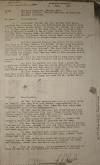
|
1 July 1932.
Intelligence.
Col. L. L. Leech,
Bluefields, to Jefe Director GN Managua.
"Subject:
Intelligence. ¶ 1. Lieutenant Curcey,
GN, upon arrival from Wauni, reported
the following to me. His information was
received from a Juez de Mesta, Nicola
Gomez [Nicolás Gómez], of Isica, Rio
Grande, who, while on a coffee buying
trip on the Tuma River, was captured by
Pedron Altamirano’s bandit group on
their retreat from their activities
about Neptune Mine, and after being held
several days made his escape. Lieutenant
Curcey states Gomez is well known to him
and that his veracity is unquestioned.
He reported as follows: ¶ (a) That
General Peralta was killed in the
contact with Gray on 24 May. (Reason for
belief, if was being discussed by the
bandits and Pedron himself was heard to
say “Why does General Peralta take such
chances.” The fact that he was never
seen after the contact and that he was
known to have been standing beside his
bugler, when Gray exploded a rifle
grenade within a few feet of them.) ¶
(b) That the bandits admitted 17 dead
after Gray’s contact, 2 dead after
Curcey’s contact, and many killed by air
bombs. ¶ (c) That the bandits had with
them 1 Lewis Gun, 2 BAR’s and 2 STMG’s.
That they had little ammunition, no
clothes, no salt, no provisions and that
most of the group were sick and daily
some would drop by the road side and be
left behind. ¶ (d) That Pedron and
Sub-chiefs told their men that they were
going back to their headquarters and
rest up and later return to attack Wauni
and Siuna and raid the Rio Grande River.
¶ (e) That Petron’s headquarters were in
a Cerro known as “Cedro”, four days from
Isla Grande – approximately at a point
16.6-F.2. 5th Regt. Map. That there are
four large camps within a few miles of
his headquarters. ¶ (f) That Pedron’s
followers are disgusted and would quit
but they fear reprisal from their former
friends and from Pedron himself if they
did. That Pedron is not popular with his
followers, and that there is much
dissention. ¶ (g) That a mine at
Parasca, owned by Germans was sacked by
Pedron and 50 pounds of dynamite carried
away. ¶ (h) That the purpose of the
concentration at Neptune Mine was its
capture, seizure of gold and other
supplies and then go down the Waspuk and
into Honduras to buy arms, ammunition
and other supplies. ¶ (i) That they were
much disappointed over their failure,
and that the rank and file blamed their
leaders. Their morale was very low. ¶
(j) That during the operations around
the mine the bandits lost at least 60,
either killed in contacts, by bombs, and
sickness, caused from starvation and
exposure. ¶ 2. From the foregoing, the
achievements of Lieutenants Gray and
Curcey are noteworthy and the more to be
commended. ¶ L. L. LEECH"
|
|
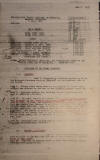
|
1 July 1932
Excerpts from
GN-2 Intelligence Report covering
the month of June.
[NOTE:
These excerpts constitute the sum total
of text devoted to the Atlantic Coast
region in this 33-page intelligence
report covering the entire country for
the month of June, except for the
declaration of Agustín Rivera (28 May).
The image to the left is the report's
cover page only.]
" [p. 1] . . .
LOCATION OF THE ENEMY ELEMENTS [none in
the Eastern Area] . . . ¶ [p. 4] UNITS
IN CONTACT ¶ . . . MAY 27 – Lieutenant
Curcey and Wauni patrol consisting of
nineteen enlisted and six civicos had
contact with rear guard of Pedron
Altamirano group under Irias at 1640,
about four hours west of NEPTUNE MINE on
LIMON trail. Fighting lasted twenty-five
minutes. No known bandit casualties. No
guardia casualties. Bandits were driven
off leaving considerable amount of loot
and leaving cattle and miscellaneous
articles behind, major portion of which
was returned to the owners. ¶ . . . [p.
6] June 23 – Lieutenants Gamaelius,
Montes and Uriza and Consuelo patrol of
30 enlisted had contact with Pedron
Altamirano and large bandit group due
north of Consuelo near the Tuma river .
. . Bandit casualties five known killed.
No guardia casualties. Guardia captured
three rifles and small quantity of bombs
and ammunition. Bandits were driven off
and scattered. ¶ June 25 – Lieutenant
Uriza and Consuelo patrol had contact at
1130 with Pedron Altamirano and group of
60 near PIEDRA LUNA. Bandits finally
withdrew and headed northward in
direction of Maximo Rivas. Bandit
casualties, one killed and indications
of several wounded. Guardia casualties
one wounded. ¶ . . . [p. 12] WEEKLY
SUMMARY OF INTELLIGENCE: WEEK ENDING 13
JUNE 1932. ¶ . . . [p. 13] The EASTERN
AREA reports all quiet on the Atlantic
Coast. ¶ . . . [p. 16] WEEKLY SUMMARY OF
INTELLIGENCE: WEEK ENDING 27 JUNE 1932.
¶ PRINCIPAL BANDIT GROUPS REPORTED
DURING WEEK: ¶ SIMON GONZALEZ and group
of 40 to 80 reported operating in
vicinity of SAKLIN and KUM on COCO
RIVER, DEPARTMENT OF NORTHERN
BLUEFIELDS. ¶ PEDRON ALTAMIRANO has been
operating South of the TUMA RIVER as far
South as CONSUELO for past week. His
group reported at about 100. ¶ . . .
GENERAL INFORMATION: ¶ On the whole the
week has been quiet. ALTAMIRANO’S
operations South of the TUMA have been
the only important movement on the part
of the bandits. ¶ . . . [p. 17]
ESTIMATE: ¶ The present increased
activity of PEDRON ALTAMIRANO South of
the TUMA was more or less expected after
the severe reversals he suffered in the
vicinity of the NEPTUNE MINES. . . . No
bandit activity is looked for during the
coming week in the . . . Eastern Area. .
. ."
|
|
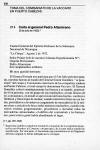
|
(5 July
1932) vs. 2 August 1932.
Carta de Gen.
Augusto C. Sandino, Cuartel
General del EDSNN, to Gen. Pedro
Altamirano, "La Chispa."
Source:
A. C. Sandino, El
pensamiento vivo, v. 2, pp. 232.
NOTE:
This letter comes from
Somoza's book, El verdadero Sandino, pp.
351-352, and is dated August 2. The
editor & compiler of Sandino's collected
works, Sergio Ramírez, assigns it a date
of 5 July. In a footnote Ramírez
explains: “Esta fecha establece cuándo
tomado el comisariato de la compañía
bananero Vaccaro Brothers & Company, en
tanto que la de la carta indica cuándo
fue suscrita ésta. Por otra parte, el
documento que presentamos es un
fragmento del texto original; la fuente
trabajada así lo consigna.” (PV2, p.
232). The “texto original” to which
Ramírez refers is Somoza’s excerpt,
presented below. I do not agree with
Ramírez's reasoning here. How does the
“carta indica”? He does not say. The
August 2 date seems to me much more
likely. In the first sentence, Sandino
talks of July as if it has already
passed by (“el 5 de Julio próximo
pasado”). We have also seen that it
could take 3-4 weeks for news to reach
Sandino at his Cuartel General deep in
the interior (recall that on 25 October
1931 he wrote about Adolfo Cockburn as
if he were still alive, three weeks
after Cockburn’s death on 4 October).
There is nothing in the letter to
suggest an immediate proximity to the
events being described; it is solidly
past tense. In sum, there seems no
reason to suppose that Somoza got the
date wrong, so it is included here under
the date assigned in Somoza’s book:
August 2, 1932.
But for convenience it is also included
here.
"Cuartel General del
Ejército Defensor de la Soberanía
Nacional de Nicaragua. ¶ La Chispa,
Agosto 2 de 1932. ¶ Señor, Primer Jefe
de nuestra Columna Expedicionaria N° 1.
¶ General Divisionario Pedro Altamirano
¶ Mi muy querido hermano: ¶ El General
Estrada nos participa que el 5 de Julio
próximo pasado, nuestras fuerzas al
mando del General Simón González, “ se
posesionó” del campo y Comisariato más
fuerte de las compañías yankees en
Puerto Cabezas, el cual campo le
denominan Vaccaro. El General González
colocó estratégicamente las fuerzas a su
mando, penetrando él en persona, con un
grupo de sus muchachos, al más famoso de
los comisariatos, en donde se
aprovisionó de botas fuertes, sombreros
Stentson y finos trajes de montar;
cuando estuvieron listos en esa forma,
procedieron a levantar un cargamento de
mercaderías de la misma clase y
artículos de boca; todos nuestros
muchachos, cuando estuvieron vestidos
gogueramente, procedieron a incendiar
todas las mercaderías almacenadas, el
edificio del comisariato y los
barracones, pues toda la gente había
abandonado el lugar. [¶ Patria y
Libertad ¶ A. C. Sandino]"
|
|
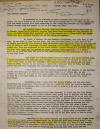
|
6 July 1932.
Letter from A. O.
Danneberger, Bilwi, to C. Conrad
Shimer, Moravian Church, Bluefields.
"Dear Brother Shimer:- ¶ It certainly is
no pleasure to write letters from this
part of the coast, for there seems to be
nothing else but discouraging news to be
sent. During the last few weeks bandits
have been operating in the Sandy Bay
district and the unrest caused through
them has spread as far as the Cape and
Yulu. ¶ The bandits passed through Wasla
and Kum and from there they went on to
Bemuna. According to reliable reports
they have done no damage to our property
in Wasla. In Bemuna they converted our
little church into a dance hall. But
everywhere they have stripped the
Indians of all their belongings. ¶ Mr.
Wendt, a German, who was hunting
alligators, run into them in Bemuna. He
was kept by them for two days, but when
he could prove to them that he was of
German nationality they released him. He
reports that they were about 30
Nicaraguans with 15 Indians, well
organized and well equipped with rifles,
5 machine guns, mules, horses, etc. They
had expressed to him their hatred
against everything American and told him
that they would use the machete on every
American they meet with, as a bullet
would be too good for him. The work of
our missionaries was not mentioned as
long as he was with them. ¶ Last night
the bandits broke out at a farm on the
upper railway line. A young Englishman
was murdered most cruelly. His body will
be brought in today and I have been
asked to keep the funeral. The bandits
looted the commissary and then burnt it
down. Earlier in the morning I heard
that they had been in Tulu, but this
report has not been confirmed and
apparently it is false. ¶ I have spoken
with the captain concerning the removal
of the National Guardia from Kisalaya.
He told me that the post there is a
little use, as the bandits go round it
and get to the coast anyhow. He believes
that better work could be done by a
stronger guard at the Cape which will be
able to control the river from there. ¶
Yesterday I had a talk with the Indian
Sindico and his secretary concerning the
landlease which we pay for the territory
which the mission occupies. So far we
have been paying $60. I got him to put
it down to $40 and so we made a new
contract which he signed. ¶ I have
dismissed Forbs from services, at least
for the time being. He stayed in Bilwi
for a whole month without even going
back to Krukira for the Sunday. Nitario
had returned to Sisin with his family,
but apparently it is not safe for him to
stay there. I, therefore, advised him to
live in Trakis where he has a house and
from there he is to pay visits to Sisin,
Krukira and Tura. He will go to Krukira
and to Sisin twice each month, each time
keeping Friday afternoon service and the
regular Sunday services. One place is
about 3 hours walk and the other 8 hours
from Trakis. On Saturdays he is to get
the children together for reading and
singing. He could not keep regular
school anyhow, as the Krukira people
have a community school and the few
Sisin children are practically all
naked. I think this arrangement will
meet your approval. It will keep Nitario
busy and is the best which we can do
under the present circumstances. ¶
According to the latest reports our
evangelists on the Wangks river are
still on their posts. Waspuck Mouth and
Sangsangta have been burned down, I was
told by Benni Mueller coming from the
Wangks. But it seems that they did not
destroy the mission house at Sangsangta.
Today’s texts, on the day of John Huss’
death, were most comforting. May the
time of building and planting soon come
again for us!"
|
|
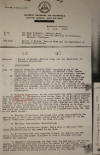
|
8 July 1932.
Record of Events, Eastern Area and the
Department of Southern Bluefields,
Col. L. L. Leech,
Bluefields, to Jefe Director GN Managua,
p. 1.
"Subject: Record
of Events, Eastern Area, and the
Department of Southern Bluefields. . . .
¶ E INTELLIGENCE. ¶ June 10 Guardia
Commander NEPTUNE MINE reported group of
one hundred in vicinity of WEILAKA, on
WASPOOK RIVER. Number of rifles,
automatic, Jefe, direction of movement.
Unknown. ¶ June 20 SIMON GONZALES, with
a group of from 40 to 80 with many
rifles and 5 automatic reported in
vicinity of SACKLIN and KUM moving in
the south. Report made by Company Agent
and the Cockburn family. On 21 and 24
June, this same group was reported by
Company agent to be in the vicinity of
KUM, SACKLIN and BAYMONA, direction of
march or activity not known. Reported to
have 40 rifles, 4 automatics and 2 rifle
grenade dischargers. ¶ 2. Military
Situation: - Do not anticipate any large
concentrations of bandit groups in the
Eastern area during June. It is probably
however, that the SIMON GONZALEZ group
will conduct raids in the Northern
Department in an effect to obtain
supplies avoiding any contact with the
Guardia. The influence of the Guardia
Posts at CABO GRACIAS and MOSS FARM, as
a result of the withdrawal of the
Guardia from KISALAYA on 24 June, should
aid these posts materially in putting
roving patrols in the field and check
any designs GONZALEZ might have on
commissaries along the line or the small
farmer. ¶ 3. Economic Situation:-
Continues very good. Approximately the
same amount of fruit was shipped during
June as mentioned in the May report.
Conditions generally for the Area are
good. ¶ 4. Sanitary Conditions:-
Satisfactory. ¶ 5. Political Situation:-
Quiet. There were no National Political
Demonstrations on the coast during June.
¶ 6. No friction has been reported
between the Guardia and the civil
population. The press continues to show
a friendly attitude towards the Guardia.
¶ 7. Weather:- Considering the fact that
the wet season has set in, weather
conditions have been good and favorable
for patrolling. River and coastwise
transportation schedules have been
regular. Visibility for air
reconnaissance has been good. There were
showers and at times heavy rains during
the entire period covered by this
report. . . . "
|
|
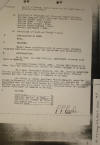
|
8 July 1932.
Record of Events, Eastern Area and the
Department of Southern Bluefields,
Col. L. L. Leech,
Bluefields, to Jefe Director GN Managua,
p. 2.
" . . . 8. Condition of Telephone and
Telegraph Communications:- ¶ Civilian
Tropical Radio Telegraph Company –
Excellent. Guardia NEPTUNE MINE – Good.
Guardia WUANI – Not heard. Guardia CABO
GRACIAS – Fair. Guardia PUERTO CABEZAS –
Fair. Guardia BLUEFIELDS – Fair. ¶ 9.
Conditions of Roads and Trails – Good. ¶
F CONFISCATION OF ARMS. ¶ None. ¶ G
TRAINING. ¶ Except where interfered with
by patrolling, training schedules have
been maintained. Discipline has been
satisfactory. ¶ H MISCELLANEOUS ¶ On 11
June, the Jefe Politico, BLUEFIELDS,
returned from leave in MANAGUA. ¶
Lieutenant Colonel PRICE, USMC., visited
BLUEFIELDS on 11 June. Visit was
unofficial and cleared for PUERTO
CABEZAS on 12 June. ¶ On 5 June,
Lieutenant PHILLIPS, (R), GN., arrived
BLUEFIELDS for the purpose of installing
a Guardia Radio. The first official
message was sent via this radio to
MANAGUA on 13 June. ¶ Sr. Rafael A.
HUEZO, Assistant General Manager, Banco
Nacional de Nicaragua, arrived
BLUEFIELDS 24 June, and assured all
depositors that the Bank would assure
all responsibility for the loss suffered
by the bank as a result of recent
irregularities. Sr. HUEZO, cleared
BLUEFIELDS for MANAGUA on 28 June. ¶ I
CIVICOS. ¶ BLUEFIELDS 74, DISTRICT
SEQUIA – AL RAMA 13, DISTRICT RIO GRANDE
– LA CRUZ 10, RIO GRANDE BAR 12, NEPTUNE
MINE 95 ¶ L. L. LEECH"
|
|
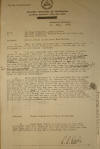
|
11 July
1932.
Recent Events in Northern Bluefields,
Col. L. L. Leech,
Bluefields, to Jefe Director GN Managua.
"Recent
events in Northern Bluefields. ¶ 1.
There is being forwarded under separate
cover, complete reports of the recent
events in Northern Bluefields, as
experienced by the individuals
concerned. ¶ 2. I am not satisfied with
the total absence of information of the
bandit approach, to within a mile and a
half of a strong well officered and well
armed guardia force. Nor am I satisfied
with the reaction on the part of Lt.
Gaitan, when the affair broke. It
appears that several days before the
raid on the commissary a small raiding
party had appeared in Ayapini and stolen
some animals, and that the day before
the raid on the commissary Gaitan was
informed that the bandits were close by,
but only laughed and took no action.
Orders are to run down all likely
rumors, and Captain Davies has been
instructed to report on the breaking
down of his intelligence system and
Gaitan’s failure to act promptly on
receipt of reliable information. ¶ 3.
Lieutenant Peterson is to be commended
for his energy and initiative in rapidly
pursuing the bandits and finally making
contact with a portion of them. The
planes under Lieutenant Coffman and
Gy-Sergeant Williams, aided materially
in dispersing the bandits and the bombs
they dropped must have been effective,
for in a reconnaissance flight Friday
July 8th over the bombed area, five
bodies were observed in a stream bed,
being eaten by buzzards. It is believed
that the group bombed and which fired on
the planes, striking Gy-Sgt Williams’
plane five times, was the main body, and
that the group Lt. Peterson contacted
was the rear guard. It is believed the
bandit group is still in the heavy
wooded country adjoining Locus creek,
and patrols will be active, weather
permitting. ¶ 4. Lieutenant Gaitan is
requesting by this mail a transfer from
this coast. He has been talking about it
for some time, and it is not felt that
the recent occurrences have been
instrumental in any way of hastening his
request. ¶ L. L. LEECH"
|
|
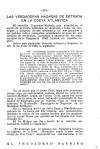
|
1.
15 July 1932.
Excerpts from
Anastasio Somoza García's El
verdadero Sandino, p. 350 (includes
July 15 letter from Gen. Francisco
Estrada, near Puerto Cabezas, to Gen.
Sandino, and the statement of Dr.
Molgar).
"LAS
VERDADERAS HAZAÑAS DE ESTRADA EN LA
COSTA ATLÁNTICA. ¶
El cabecilla Francisco Estrada, que
actuaba en el sector de la Costa
Atlántica, se dedicaba a falta de
enemigos a despojar de sus cosechas y de
sus ganados a los pobres indios
mosquitos, cometiendo de paso un
sinnúmero de asesinatos, incendios y
saqueos en los comisariatos de la
Bragmann Bluff Lumber, en aquella
región. ¶ Sobre este
particular Estrada informó a Sandino, el
día 15 de Julio de 1932, lo siguiente:
¶ “Me es altamente honroso
comunicar a Ud. que el día 13 de los
corrientes llegó a nuestro Campamento de
Wuiyunak, nuestro hermano General Simón
González, después de haber hecho un
brillante recorrido por el propio
corazón de nuestro Litoral Atlántico,
pues estuvo a tres leguas de el Cabo de
Gracias a Dios. El 5 de este mes
el General González, entró al
Comisariato de la Bacaro, a kilómetro y
medio de Moss, extrayendo de él la mayor
cantidad de mercaderías e incendiado
todo lo almacenado, junto con el
edificio de la compañía. Siendo
capturado el mandador de nacionalidad
yanqui y apellido Cook a quien se le
quitó una pistola automática No. 45.
Este individuo fue pasado inmediatamente
por las armas, junto con un hombre de
color, que el era el Encargado del
Comisariato.” ¶ No es cierto
que el joven Cook haya sido
norteamericano, sino de nacionalidad
inglesa, siendo su verdadero nombre
Herbert Leslie, de Veraux. Cook,
quien fue asesinado a los 19 años de
edad, habiendo protestado al Gobierno de
Nicaragua por su muerte, como se verá
más adelante, el Honorable Encargado de
Negocios de su Majestad Británica.
¶ En la mañana del 18 de Julio
llegó a Bluefields procedente de la
barra del Río Grande, una embarcación,
llevando la nueva de los asaltos hechos
por los sandinistas, en varias fincas
que quedan en las riberas del mencionado
río. ¶ El Dr. Molgar que iba
a bordo de la referida embarcación,
refirió lo siguiente: ¶ “El
domingo por la mañana los foragidos
hicieron su ingreso en la finca
‘Morazón’, como a seis millas abajo de
‘La Cruz’, saqueando los comisariatos, y
ro-[bándose] . . ."
|
|
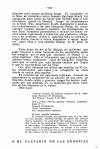
|
2.
15 July 1932.
Excerpts from
Anastasio Somoza García's El
verdadero Sandino, p. 351
(concludes statement of Dr. Molgar; and
Aug. 2 letter from Sandino to Gen. Pedro
Altamirano).
" . . .
[ro]-bándose todo cuanto pudieron tomar.
El mandador de la finca, un ciudadano
suizo llamado Santiago Shack, fue
capturado, pero luego de haber sido
llevado ante el jefe bandolero, quedó en
libertad. Lluego se constituyeron
en la finca ‘Pan American’, donde
capturaron y asesinaron cobardemente a
los tres hermanos Hislop, de
nacionalidad inglesa; saqueron también
los Comisariatos de esta finca; asimismo
procedieron a invadir las fincas
circunvecinas, capturando a todos los
que pudieron; obligaron a los hombres
civiles a acarrear todo lo robado, y
luego dieron muerte a varios, llevándose
a varias mujeres, entre ellas a una
señorita Hislop, de 13 años de edad.’
¶ Tales datos los dio al Dr.
Molgar, un individuo que pudo lanzarse a
nado, huyendo de los sandinistas, quien
fue recogido por el bote que conducía al
Doctor y a otros fugitivos. Dijo
el informante que el grupo de bandoleros
estaba compuesto domo de cincuenta
hombres, pero que se sabía que más
fuerzas estaban por llegar y que se
encontraban por La Cruz. ¶
Con tales informes los civiles que
residían en El Gallo, abandonaron este
lugar y se refugiaron en otros donde se
creían más seguros. ¶ En
relación con los anteriores informes,
creemos de importancia la traslación de
un párrafo de una carta de Sandino,
donde relata a grandes rasgos los hechos
realizados por sus soldados en la
incursión que éstos hicieron en los
dominios de la Cukra. ¶ Helo
aquí: ¶
"Cuartel General del Ejército Defensor
de la Soberanía Nacional de Nicaragua.
¶ La Chispa, Agosto 2 de 1932.
¶ Señor, Primer Jefe de nuestra
Columna Expedicionaria N° 1. ¶
General Divisionario Pedro Altamirano
¶ Mi muy querido hermano: ¶
El General Estrada nos participa que el
5 de Julio próximo pasado, nuestras
fuerzas al mando del General Simón
González, “se posesionó” del campo y
Comisariato más fuerte de las compañías
yankees en Puerto Cabezas, el cual campo
le denominan Vaccaro. El General
González colocó estratégicamente las
fuerzas a su mando, penetrando él en
persona, con un grupo de sus muchachos,
al más famoso de los comisariatos, en
donde se aprovisio-[nó] . . . "
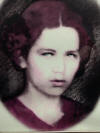 NOTE:
In February 2014, I
received an email from Marina Toledo, a
descendent of the Hislop family living
in New Orleans; excerpts from her
message follow; photograph at right is
her grandmother, Victoria, who survived
the attack and died in 1946: "My father, Adan
Alberto Toledo, was born in 1945 in
Managua. He was the youngest of three
brothers born to Victoria Hislop and
Nicolas Toledo. My grandmother died in
Puerto Cabezas of tuberculosis in 1946
(supposedly when she was in her late
20's). ¶ My father and his
older brothers were raised by their
maternal grandmother. My dad grew up
hearing stories from her of how Sandino
and his men where butchers and thieves.
Victoria's mother was the one who passed
down the story of how Victoria's father
and family were killed before them corte
chaleco style. Victoria's mother told
the boys how Sandino and his men would
intimidate and robbed business owners;
she passed away in 1959, but my father
never forgot her stories describing
Sandino as a common thug. ¶
Victoria Hislop was one of a handful of
survivors of the attack. I don't know
what happened after the 1932 events, but
she ended up in Managua in 1940, since
that is when she met Nicolas Toledo.
They moved east to Puerto Cabezas until
her death in 1946. My grandfather
abandoned their three children, who were
raised by Victoria's mom. ¶
My father and uncles were very
anti-Sandino, which is the reason we
fled Nicaragua during the revolution. We
moved to New Orleans and it has been our
home since then. My oldest uncle was
Somoza's helicopter pilot and my father
attended the military academy. He didn't
go further than that with the military
as he went to the university and
graduated with a business administration
degree. However, his hatred of Sandino,
and anything communist remained until
his passing in 2008. He was a Somoza
loyalist, as was his oldest brother.
Interestingly, the middle brother,
Humberto, was a Sandinista. ¶
In 1998, my father and I went to Puerto
Cabezas so we could see where he grew
up. We were able to get a picture of my
grandmother from a woman whom she had
helped raise, Dinorah. Her family still
owns the only inn in town. Victoria was
fair skinned and had blue eyes. Dinorah
also gave my father a quilt Victoria had
made while she was pregnant with him. ¶
Thank you for your website as it has
been a wonderful resource. It has been
interesting to read the actual recorded
the events, which I had only heard from
my father. Please keep me in mind if you
run across additional details on the
Hislop family in your future research."
Marina Toledo, Esq., 1101 Veterans
Blvd., Suite 10, Kenner, LA 70062. NOTE:
In February 2014, I
received an email from Marina Toledo, a
descendent of the Hislop family living
in New Orleans; excerpts from her
message follow; photograph at right is
her grandmother, Victoria, who survived
the attack and died in 1946: "My father, Adan
Alberto Toledo, was born in 1945 in
Managua. He was the youngest of three
brothers born to Victoria Hislop and
Nicolas Toledo. My grandmother died in
Puerto Cabezas of tuberculosis in 1946
(supposedly when she was in her late
20's). ¶ My father and his
older brothers were raised by their
maternal grandmother. My dad grew up
hearing stories from her of how Sandino
and his men where butchers and thieves.
Victoria's mother was the one who passed
down the story of how Victoria's father
and family were killed before them corte
chaleco style. Victoria's mother told
the boys how Sandino and his men would
intimidate and robbed business owners;
she passed away in 1959, but my father
never forgot her stories describing
Sandino as a common thug. ¶
Victoria Hislop was one of a handful of
survivors of the attack. I don't know
what happened after the 1932 events, but
she ended up in Managua in 1940, since
that is when she met Nicolas Toledo.
They moved east to Puerto Cabezas until
her death in 1946. My grandfather
abandoned their three children, who were
raised by Victoria's mom. ¶
My father and uncles were very
anti-Sandino, which is the reason we
fled Nicaragua during the revolution. We
moved to New Orleans and it has been our
home since then. My oldest uncle was
Somoza's helicopter pilot and my father
attended the military academy. He didn't
go further than that with the military
as he went to the university and
graduated with a business administration
degree. However, his hatred of Sandino,
and anything communist remained until
his passing in 2008. He was a Somoza
loyalist, as was his oldest brother.
Interestingly, the middle brother,
Humberto, was a Sandinista. ¶
In 1998, my father and I went to Puerto
Cabezas so we could see where he grew
up. We were able to get a picture of my
grandmother from a woman whom she had
helped raise, Dinorah. Her family still
owns the only inn in town. Victoria was
fair skinned and had blue eyes. Dinorah
also gave my father a quilt Victoria had
made while she was pregnant with him. ¶
Thank you for your website as it has
been a wonderful resource. It has been
interesting to read the actual recorded
the events, which I had only heard from
my father. Please keep me in mind if you
run across additional details on the
Hislop family in your future research."
Marina Toledo, Esq., 1101 Veterans
Blvd., Suite 10, Kenner, LA 70062.
|
|
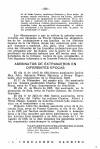
|
3.
15 July 1932.
Excerpts from
Anastasio Somoza García's El
verdadero Sandino, p. 352
(concludes Aug. 2 letter from Sandino to
Gen. Pedro Altamirano; list of alleged
EDSN murders April 1931-August 1932; and
27 Aug. letter from Gen. Pedro Antonio
Irías to Sandino).
" . . .
[aprovisio]-nó de botas fuertes,
sombreros Stentson y finos trajes de
montar; cuando estuvieron listos en esa
forma, procedieron a levantar un
cargamento de mercaderías de la misma
clase y artículos de boca; todos
nuestros muchachos, cuando estuvieron
vestidos gogueramente, procedieron a
incendiar todas las mercaderías
almacenadas, el edificio del comisariato
y los barracones, pues toda la gente
había abandonado el lugar."
** ¶
Los ‘Barracones’ a que se refiere la
anterior comunicación son llamados en
Puerto Cabezas los alojamientos de los
trabajadores y sus familias en los
distintos lugares de la vía férrea,
donde hay estaciones para cargar bananos
o maderas. Así, pues, esos
‘barracones’ eran las viviendas de los
humildes trabajadores que fueron
arrasadas por las llamas por la gente de
Sandino, perdiendo a los míseros haberes
que allí tenían esos desheredados de la
fortuna; hechos de que, complacido, el
Jefe Supremo informaba a su favorito
Pedrón Altamirano.” ¶
ASESINATOS DE EXTRANJEROS EN
DIFERENTES EPOCAS ¶
El día 11 de Abril de 1931, fueron
asesinados Lucián May, John Salomon,
Walter Manning y Henry Roger, todos
ellos trabajadores de la Bragmann Bluff.
¶ El 17 de Diciembre del mismo
año, fue asesinado por las huestes
sandinistas Charles Eliseo Haslam, en
Siuna, cerca de Wany, departamento de
Bluefields. ¶ El día 16 de
Enero de 1932, fue asesinado en la
plantación de Sula, cerca de Puerto
Cabezas, Mr. Herbert Seymour. ¶
El día 17 de Julio de 1932, fueron
asesinados, cerca de ‘La Cruz del Gallo’
los señores Clayton, Albert y Willie
Hislop, después de haberles robado todo
cuanto tenían en el comisariato a su
cargo. ¶ Roberto Allen fue
también asesinado cerca de la hacienda
Sula, cerca de Puerto Cabezas, el día 16
de Enero de 1932, por fuerzas
sandinistas, viniendo a sumarse éstos a
la lista macabra que antes publicamos, y
que Pedro Antonio Irías trasmitió a su
Jefe, en carta de 11 de Agosto de 1932,
de la cual tomamos los siguientes
párrafos, respetando como siempre la
ortografía: ¶ ‘CAMPAMENTO DE
OPERACIONES MILITARES, LAS CUCHILLAS,
AGOSTO 11, 1932 ¶ Señor Jefe
Supremo Gral. César Augusto Sandino.
¶ . . ."
**
Note of Sergio Ramírez on this document:
“Esta fecha establece cuándo tomado el
comisariato de la compañía bananero
Vaccaro Brothers & Company, en tanto que
la de la carta indica cuándo fue
suscrita ésta. Por otra parte, el
documento que presentamos es un
fragmento del texto original; la fuente
trabajada así lo consigna.” PV2:
p. 232. [NOTE: The “texto original” to
which Ramírez refers is Somoza’s
excerpt, presented here.]
|
|
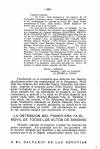
|
4.
15 July 1932.
Excerpts from
Anastasio Somoza García's El
verdadero Sandino, p. 353
(concludes Aug. 27 letter from Gen.
Pedro Antonio Irías to Sandino).
".
. . Cuartel General. ¶ . . .
El 17 de Julio llegamos a los campos de
la Compañía rompimos varios comisariatos
y nos cruzamos el río, continuando la
marcha en vusca del lugar donde
peranecía el Gral. Adán Gómez, donde
llegamos ese mismo día a las 5 de la
tarde. ¶ En esta gira no
peliamos pues el enemigo no nos busca
por los lugares que nosotros nos
crusamos, siempre nos buscaban por
lugares distintos. Nosotros mandamos
chalequiar 15 traidores entre ellos los
jefes de los Comisariatos y
Representantes de la Compañía en Río
Grande y son los siguientes: Río Grande
Cleto Wilcock, Alberto Wilcock, y Wili
Wilcock, hermanos los tres; Juan Angulo,
Juan Blandón, Gregorio Abarca y Teodoro
Aberuz, éstos eran jueses de los machos
. . . En Kepi, Río Tuma, a Inés
Gutiérres, Feliciano Rosalio y Pantaleón
Gutiérrez familiares todos; Tomás Cruz y
María Sánchez. En Veracruz, Río
Quiguasca, Pedro Amador; en Timulí,
Chontales, Victor Manuel Hernández Juez
de los machos. Así doy a Ud. el
informe de la Jira; un soldado de
Capitán Tobares lo mató el enemigo pues
tomó mucho licor y lo encontraron caído
de la borrachera en la picada y lo
mataron, pero otra novedad no huvo. — El
muerto se llamó Santos Arceda, del Río
Yaosca. ¶ Patria y Libertad
¶ General y Jefe en Comisión.
¶ (f) PEDRO A. IRIAS.’ ¶
Finalmente en la incursión que hicieron
las fuerzas sandinistas sobre los
comisariatos de la Bragmann Bluff, bajo
las órdenes del cabecilla Simón
González, fue asesinado también el
honrado joven Félix Octavio Ramírez y
tres niños. Su cuñado, el Dr. Francisco
Mongalo, distinguido facultativo,
residente en Puerto Cabezas, hizo
conducir su cadáver a aquella población,
en donde se le dio cristiana sepultura,
en medio del sentimiento de pesar de los
muchos amigos que apreciaron al extinto.
. . ."
|
|
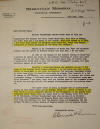
|
15 July
1932.
Letter from C.
Conrad Shimer, Bluefields, to Dr.
S. H. Gapp, Moravian Church, Bethlehem
PA.
"Dear Brother
Gapp, ¶ Brother Danneberger
writes under date of July 1st ¶
Apparently the bandits are still round
Sandy Bay. They were at Bemuna, and
there they had a big dance in our
church. They also showed up in
Kuri, a few hours walk across the
savannah from Sandy Bay, where they
helped themselves to cattle belonging to
the Sandy Bay Indians." ¶
Bemuna is an outstation of Sandy Bay.
What the distance between the two places
is Brother Bishop can tell you, I do not
know. ¶ In view of the
danger of the bandits coming to Sandy
Bay I believe we should not think of the
Bishops returning at least till next
Spring. And I do not know where
else we could place him. Of course such
a possibility would have to wait for
Brother Grossman’s return, but they
certainly cannot go to Sandy Bay.
¶ Recently a young Englishman was
murdered on one of the farms of the
Bragman Bluff Lumber Company. I do not
think any very serious effort is being
made to put down the bandits. The
National Guardsmen always go after them
after the bandits have made an attack.
They usually do a lot of damage to the
bandits, too, but nevertheless fail to
prevent the attack and consequent
damage. A statement made by the
father of the murdered young man, which
statement I saw here, says that the
Guardia knew of the intended attack in
which his son was killed, but seemed
disinterested and did nothing about it.
¶ Our upper coast is still in
danger and no missionaries should be
sent where there are no Guards.
There is a force of Guards at the Cape
which is to be augmented shortly by the
withdrawal of the guards from Kisalaya
above Wasla. Thus our whole work
on the Wangks river will have to be
abandoned. Brother Danneberger
says that he has it on reliable
authority that Sangsangta and Waspuck
Mouth were recently destroyed by fire
from the bandits, but that the Mission
house at Sangsangta was not harmed.
We have a little church at Waspuck
Mouth, but no mission house. ¶
With kind greetings, ¶
Fraternally yours, . . . "
|
|
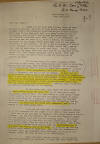
|
20 July
1932.
Letter from Kenneth G. Hamilton,
Bluefields, to
Dr. S. H. Gapp, Moravian Church,
Bethlehem PA, p. 1.
"Dear Bro. Gapp:-
¶ Thank you for your last letter,
which we were pleased to receive.
We know you have plenty of problems to
struggle with – the financial condition
as put in the circular which came in the
same mail must be a heavy burden on all
to the Boards – and we don’t want to add
any unnecessary ones. Our
financial donation here, while bad, is
not desperate. At present we owe
one large bill, about $190.00, for
supplies purchased for the Sunday School
last fall, and not yet paid.
Otherwise, we are solvent. We had
to pay a premium of $100.00 on the
insurance of our Church and Sunday
School Hall, and at first did not know
where it could come from. But our
people rallied to the need, when they
were told of it, and gave in the annual
“S.S. Self Denial Offering” over $60.00.
With that amount to help, we will be
able to pay the premium out of current
receipts. ¶ If for any
reason the fruit companies should stop
work in this coast, the effect on our
work would be crippling. But we
hope and pray, that this may not happen.
It is getting very difficult for them to
carry on their work, however. In
this month, three of their commissaries
have been looted, two up the line in
Bragman’s, and one up the Rio Grande.
We have not yet heard reliable details
about the latter, but there is a
suspicion that it was done not by
regular Sandinistas, if that is a
permissible term, but by embittered
ex-employees of the company. There
seems to have been a considerable number
of men murdered there, and, what is
worse, some women carried off.
However, there is as yet no official
confirmation of the reports. ¶
In the other case, only three men were
killed by the Sandinistas during the
raid, but one of them was a young
Englishman, whom we knew. His poor
family is left without their chief
support, for he was the only boy among a
number of girls. He was just 23 or
24, I believe. In this case, the
National Guard overtook the Sandinistas
as they were retreating, had an
encounter, in which all the goods were
recovered, and quite a number of the
Sandinistas fell. . . ."
|
|
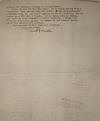
|
20 July
1932.
Letter from
Kenneth G. Hamilton, Bluefields,
to Dr. S. H. Gapp, Moravian Church,
Bethlehem PA, p. 2.
" . . .
turning the thoughts of many to things
above. ¶ Also, we are having
much rain. It is rainy season with
a vengeance. Yes, we run into Bob
Hooker often, metaphorically speaking,
that is. It isn’t healthy to do it
literally, for he weight over 200 lbs. I
think. He is doing well in school,
and settling down somewhat in other
respects, I think. He finds it
very hard, though, to manage on the
reduced salary which the teachers are
getting. ¶ With regards to
Mrs. Gapp and yourself, ¶
Sincerely yours, . . . "
|
|
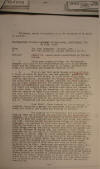
|
22 July
1932.
Report of Recent Bandit Activities on
the Rio Grande,
Col. L. L. Leech, Bluefields, p.
1.
"1. About noon
Monday 18 July, Mr. Fitzgerald, Manager
and agent of the United Fruit Co, on the
Rio Grande River and Dr. Meelgard,
physician in El Gallo, arrived hurriedly
in Bluefields and promptly reported to
me. ¶ 2. They stated that early Sunday
morning 17 July, a force of about 50
bandits, who had secretly assembled and
camped the night before within a few
miles of La Cruz, quietly approached,
surrounded the Morazon Farm Commissary
on the south bank of the Rio Grande,
captured the Farm Manager, Mr. Santiago
Schech and all the laborers around the
place, looted the commissary and keeping
all captive, proceeded down the river
for several miles, secured some boats
and crossed to the north side. During
the crossing, Mr. Schoch and several
natives managed to make their escape,
and returned to El Gallo and gave the
alarm. This, strange to say, was the
first information received that bandits
were even in the district. This seems
remarkable in view of the intelligence
net Lieut Stone and Mr. Fitzgerald has
all around the District. ¶ When Lieut
Stone learned of the situation, he
promptly organized a patrol and
proceeded down the river to where the
bandits had landed and started in
pursuit. ¶ The bandits in the meantime,
had cut across the neck of land and
surprised and captured the Pan American
Commissary. Mr. Fitzgerald had proceeded
by motor boat in the effort to warn Pan
American but arrived just after the
bandits had left, leaving behind the
mutilated bodies of the Hislop brothers.
He returned to join Lieut Stone, and
enrouge saw some of the bandits in a
banana field and opened fire on them.
Lieut Stone hearing the firing turned
back with his patrol and when Mr.
Fitzgerald joined him, and reported,
Lieut Stone promptly set off in the
right direction and Mr. Fitzgerald
returned to El Gallo. Many of those
captured had escaped and returned
excitedly to Gallo and La Cruz with the
information that Pedron with a large
force, was still encamped south of El
Gallo, and was waiting for the advance
detachment to draw Lieut Stone and
patrol from Gallo and then he would
capture El Gallo and La Cruz. Realizing
the possibility of this, Mr. Fitzgerald
tried to radio Bluefields but was
unsuccessful. The reports were so
alarming that Mr. Fitzgerald, knowing
that he could not get in radio
communication until seventeen hundred
Monday decided to proceed to Bluefields
by motor boat. On his way down the
river, about 1630, he heard heavy firing
to the north and as it later developed
that was the time Lieut Stone was in
contact with the bandits in which
contact two bandits were killed. . . . "
|
|
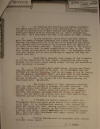
|
22 July
1932.
Report of Recent Bandit Activities on
the Rio Grande,
Col. L. L. Leech, Bluefields, p.
2.
" . . . 3. On
learning of the foregoing and making
allowance for undue anxiety on the part
of Mr. Fitzgerald, I could not ignore
the possibility of more trouble and
immediately dispatched Lieut Davis with
16 guardias by the Fruit Company Tug,
San Juan. This detachment arrived
at El Gallo at 1630, Tuesday. ¶
4. In the meantime, Lieut Stone had made
contact with the bandits Sunday
afternoon and chased them until dark.
Hearing the rumors that El Gallo was to
be attacked and having lost contact with
the bandits, he returned with his patrol
to El Gallo late Sunday evening.
Calming the fears of the populace and
resting his men, he made preparations to
take up the pursuit Monday morning which
he promptly did. His movements
since then are unknown and at noon
yesterday no reports had been received
from him. ¶ 5. Lieut Davis
promptly took charge of the situation on
the Rio Grande and at last report,
preparations were going forward for the
usual large weekly banana cutting and
conditions were returning to normal.
¶ 6. The bandits were under Irias,
Mairena and Chavalia, the latter
formerly of La Cruz. It is
believed that the information reached
Chavalia, that an old enemy of his Ed
Hislop, the Pan America commissary
owner, had much cash in his possession.
This is borne out by the methodical
search of his house and all buildings.
Mr. Hislop had left Saturday morning for
Bluefields with $1.250.00. ¶
The secret method of their approach
indicates that the raid was carefully
planned, and well executed. Just how
many people were killed is unknown,
other than those already reported.
Reports state that many of the captured
laborers were killed, and many brutally
forced to pack the loot. All the
women and children that were held
captive were released and have returned
to their homes. ¶ 7. I
believe the bandits managed to reach the
Prinzapolka River and seize boats before
Lieut Stone could catch them. It
is problematical whether they crossed
the river and struck the trail leading
northwest south of Neptune Mine, or
attempted to escape up the Prinzapolka
River. A patrol from Wauni, should
have arrived at Vacawatla yesterday.
The Bluefields Detachment will await
return of Lieut Stone prior to return.
¶ 8. Further details will be
forwarded after receipt of Lieut Stone’s
report. ¶ L. L. LEECH."
|
|
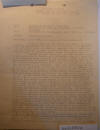
|
1.
24 July 1932.
Informe de Patrulla,
2nd Lt. Francisco
Gaitain, Cuartel de Moss, to Col.
L. L. Leech, Bluefields, p. 1.
"1. El 18 de Julio de 1932 recibí orden
verbal del Comandante del Departamento
de salir con una patrulla de 20 guardias
y dos Oficiales hacia las sabanas y
recorrer toda la región del río Coco
desde Leimos, hasta el pueblo de Cum y
tomar todas las informaciones que
pudiera obtener acerca de los
bandoleros. ¶ 2. Teniendo ya
todo organizado, salí del Cuartel de
Moss a las 5.00am con 21 alistado y el
Subteniente Leónidas López G.N. y nos
dirigimos sobre el camino que conduce a
Leimos sobre la sabana pasando por
Collotine y Licus; habiendo caminado
todo el día detuvimos nuestra marcha
para dormir en un lugar de la sabana y
continuar el día siguiente. Sobre
este camino iban las huellas de los
bandoleros que después del contacto que
tuvieron con la guardia cerda de Licus
día después de que robaron el
comisariato de Bacaro [Vaccaro], se
desparecieron en dos grupos siendo este
el mayor, pues este es el camino más
favorito por donde ellos siempre bajan
por ser demasiadamente solo y lejos.
Habiéndome constituido en el lugar de
Leimos pude observar que este grupo de
bandoleros que llevaban este camino
habían cruzado el río Coco
indudablemente para dirigirse hacia
arriba a Waspook o Sang Sang que es
donde poco más o menos se cree tengan su
campamento. Regresando la marcha
hacia atrás llegue al Cuartel viejo de
Kisalaya y obtuve las primeras
informaciones acerca de los bandoleros.
Los indios me manifestaron todos en
general que seis bandoleros habían
salido al pueblo de Saupuka que habían
tomado a tres indios mosquitos y se
habían embarcado en tres pipantes y se
habían dirigido sobre el río hacia
arriba a Leimos y que se habían juntado
con los otros y que indudablemente se
habían ido para arriba. Que estos
bandoleros al llegar a Saupuka habian
manifestado que la guardia los había
hecho paste y que ellos iban huyendo,
llendo heridos los seis pero ligeramente
solo uno con un balazo de mas gravedad y
que creían que la guardia los seguía por
eso no se detenían, siendo tres
españoles y tres mosquitos, los cuales
cuatro iban armados con rifles y los
otros dos con machete. ¶ 3.
Al día siguiente el 20 de Julio seguí mi
marcha hacia abajo en donde llegue a
Saupuka habiéndome informado de todo lo
que me habían dicho anteriormente los
indios de Kisalaya, estos indos me
refirieron lo mismo y que los tres
indios que se habían . . . "
|
|
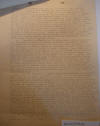
|
2.
24 July 1932.
Informe de Patrulla,
2nd Lt. Francisco
Gaitain, Cuartel de Moss, to Col.
L. L. Leech, Bluefields, p. 2.
". . . tomados los bandoleros para que
los llevaran en los pipantes no habían
regresando aun, también que estos
bandoleros al irse los habían
manifestado a los indios que ellos
regresarían muy pronto nuevamente a la
línea en mayor numero y que todo el
ganado que los indios poseen los
llevarían para arriba porque era de
ellos. Después me dirigí hacia el
pueblo de Bilwas Carma y obtuve las
mismas informaciones anteriores donde
ellos también pasaron en el mismo número
y manifestaron a los indios de allí lo
mismo que ellos regresarían muy pronto y
que se llevarían todo el ganado de los
indios. Pase por el pueblo de
Saklin en donde no obtuve mas
información que la de cuando ellos
bajaron que pasaron por allí, pero estos
seis bandoleros que pasaron por estos
pueblos antes mencionado no pasaron por
allí. Llegué en marcha hasta la
hacienda Pisquiera en donde dormí.
Por la mañana a las 7.00am emprendí
nuevamente la marcha pasando por los
pueblos de Cuncunwatla Tuscro, Wasla
hasta llegar al pueblo de Cum. ¶
4. En estos pueblos obtuve la
información solamente cuando los
bandoleros bajaron que venían de arriba
que pasaron robando y haciendo miles
zanganadas, pero toda esta gente se
corrió porque los divisaron a tiempo y
ellos no capturaron a nadie. A las
5.00pm del 21 llegue a Cum en donde me
quede a dormir y tome todas las
informaciones acerca de la llegada de
los bandoleros las que obtuve por medio
del Juez Inman (indio mosquito).
Este señor cuando los bandoleros
llegaron a Cum el se corrió y casi toda
la gente, pero ellos se habían ido
regresaron a sus casas capturándolo los
bandoleros y preguntándoles que si la
guardia llegaba por allí, uno de estos
mosquitos de nombre Elix, nombraron Juez
dándole dicho nombramiento el General
Simón González. Pero este hombre
Elix, se había ido con toda y su familia
según de manifestaron para Sandy Bay.
Por todo lo demás ellos los bandoleros
despues se habian dirigido hacia Sandy
Bay. ¶ 5. De Cum continué mi
marcha hacia Casca pasando por Pritingni
este Casca es un lugar que queda a
orilla del rio Cornok a medio día de
camino de Sandy Bay y a cinco horas de
Cum. En este Casca es un lugar
completamente apropiado para permanencia
de los bandoleros, hay varios champas es
montañosa a la orilla del rio y hay
plantaciones de bananos y cana en donde
ellos pueden comer, no vive gente.
En este mismo día continué mi marcha
hacia Suajara lugar que queda hacia el
Suroeste de Casca como a dos horas y
media de camino y lugar donde los
bandoleros han llegado mucho. A
las 8.00pm de la noche del 23 de Julio
llegue al pueblo de Suajara en donde me
quede a dormir. Habiéndole tomado
muy pulcramente información a los indios
de este lugar, me manifestaron que los
bandoleros habían estado como mas de una
semana allí, que ellos no habían podido
ir a avisar la guardia porque ellos no
les daban oportunidad que cuando
llegaron fue de noche y no dejaban salir
a nadie a ninguna parte. Que allí
permanecieron muy tranquilos y que la
guardia nunca había llegado por allí
hasta en esta fecha que yo llegaba.
Este lugar de Suajara es un pueblito de
14 casas de paja o sea hojas queda
viniendo de Casca o Cum en el llano a
orilla de la montana e illendo de
ollapine del otro lado del rio y de la
montana, es decir illendo de ollaipine a
Suajara es un lugar muy emboscado por la
montana y por el rio que es grande y se
necesita pasar en pipantes. . . . "
|
|
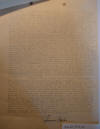
|
3.
24 July 1932.
Informe de Patrulla,
2nd Lt. Francisco
Gaitain, Cuartel de Moss, to Col.
L. L. Leech, Bluefields, p. 3.
"
. . . Hay plantación de bananos, de cano
y de eso los bandoleros comían y dormían
allí, también iban a agarrar ganado al
llano al lado de Sandy Bay, que muchas
veces pasaron por allí los aviones pero
ellos se escondían debajo de los árboles
o se metían a las casas. Que de
allí habían salido para la línea porque
ellos hacía lo habían dicho que no
habían vuelto a saber de ellos.
Que la primera vez cuando llegaron a
saquear a Sandy Bay también llegaron y
que habían estado allí algunos días.
Viven en este pueblo como 20 personas
mosquitas. A fin de quitarles ese
lugar a los bandoleros, les notifique se
fueran de allí porque la otra vez que
llegara lo allí daría fuego a todas las
casas y terminaría con todo lo que
hubiera allí. En la mañana del 24 de
Julio salí de Suajara con rumbo a
Ollapine teniendo que pasar
demasiadamente lleno tenía mucha agua y
parecía imposible la pasada. Opté
por hacer algunas balsas y probar si
podía pasar porque se me hacia forzoso
no tenia provisión y necesitaba llegar,
pues ya había cubierto la ruta que se
había señalado. Principie por hacer
balsas y pasamos todos y todas las
armas, pero los últimos en pasarse que
fueron Juan García #4478 G.N. que habían
quedado al otro lado del rio apostado
esperando la pasada de todos, al pasarse
la balsa se les rompió y los arrastro la
corriente habiéndose ahogado los tres
rifles de ellos solamente habiendo sido
imposible sacarlos por la enorme
creciente del rio. Después
continué la marcha hacia Ollapine en
donde llegue a las 7.00pm interrogando
algunos indios de allí acerca de si
sabían algo de los bandoleros me
manifestaron que no había nada que los
bandoleros no habían vuelto a llegar
desde que pelearon en Si Sing [Sinsin,
Sisin] con la guardia que pasaron por
allí. En Ollapine me embarque con
la patrulla en pipantes y seguí mi
marcha embarcado hasta el puente del
Boom en donde llegue a las 3.15m en
donde llame a la Comandancia de Moss
para que mandasen a traer en el motor
carro habiéndome reporteado por teléfono
al Comandante Departamental. ¶
6. Durante toda mi marcha por la sabana
y los lugares por donde trafique no tuve
ninguna novedad solamente en el rio
Licus la ahogad de los tres rifles en
referencia. Debo advertir que toda
esta zona que recorrí en esta fecha que
lo hice se encuentra tranquila y toda la
información que obtuve es la que narro
aquí mismo. Durante los días de mi
patrulla que fueron siete dos veces los
aviones me dejaron provisión pero con
esto y la ayuda de los pueblos por donde
pase que me ayudaban con alguna poca
provisión pude así cumplir exactamente
con lo que se me encomendó a excepción
del último día que no tenia provisión y
por esto apresure mi marcha para llegar
al Cuartel de Moss. Por este
camino que conduce directamente de Cum a
Sandy Bay y el mismo que conduce a Casca
y Suajara es el que siempre los
bandoleros han utilizado para su tráfico
para los lugares de la línea, pero ya
hoy es traficado por la guardia y será
quizás ya posible que ellos tendrán
mucho miedo al saber que la guardia
cruza ya por esos sumapos penosos.
Este es todo el informe de mi patrulla
cumpliendo así con el cometido y orden
que se me encomendó. ¶
(firma) Francisco Gaitán"
|
|

|
4.
24 July 1932.
Informe de Patrulla,
2nd Lt. Francisco
Gaitain, Cuartel de Moss, to Col.
L. L. Leech, Bluefields, p. 4.
Handwritten message accompanying
report (no author):
"Members of group recognized ¶
Simon Gonzales General ¶
Short heavy set, smooth shaven no
outstanding scars. Coffee complexion -
does not look very intelligent. ¶
Sotomayor - Secretary ¶
Orosco - Adjutant ¶ Lopez -
Believed to be ex Guardia ¶
Zacarias ¶ Arauz ¶
Camilo ¶ Centeno Pancho."
|
|

|
5.
24 July 1932.
Informe de Patrulla,
2nd Lt. Francisco
Gaitain, Cuartel de Moss, to Col.
L. L. Leech, Bluefields, p. 5.
1st Endorsement, Dept. of S. Bluefields
Commander Capt. W. W. Davies, 29 July,
and 2nd Endorsement, Col. Leech, 30
July.
|
|
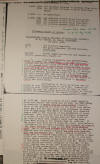
|
1.
25 July 1932.
Recent bandit activities and Guardia
offensive operations,
Capt. W. J.
Stone, El Gallo, to Col. L. L.
Leech, Bluefields, p. 1.
[From
"Guardia Nacional Newsletter No. 112,"
1-12 August 1932] "Following
report is quoted: ¶
HEADQUARTERS GUARDIA NACIONAL DE
NICARAGUA, DISTRICT OF RIO GRANDE, EL
GALLO, NICARAGUA, 25 JULY, 1932 ¶
From: The District Commander. ¶
To: The Area Commander, Guardia
Nacional, Bluefields. ¶
Recent bandit activities and Guardia
offensive operations; report of. ¶
1. A group of bandits, now authentically
known to number 77, under Pedro Irias
and Chavarria, invaded this District
from the South and came out on the Rio
Grande about three miles below La Cruz
on July 17th, at 5:30 AM. After
sacking a camp at this point they moved
East and looted the Commissariat of
Santiago Schock at Morozan (see Marine
Corps Map of Nicaragua) and still moving
East they arrived at Matagalpa farm and
then crossed to the north bank of the
Rio Grande to Terciopela in a gasoline
boat belonging the Epifanio Castro who
lives there. ¶ Information
of their operations was received at this
Headquarters at 10:45 AM. Cleared
immediately with combat patrol of ten
enlisted in Fruit Company tug boat and
after questioning persons at Morozan
arrived and disembarked at Terciopeia
(Castro’s camp) . . . "
|
|
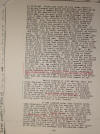
|
2.
25 July 1932.
Recent bandit activities and Guardia
offensive operations,
Capt. W. J.
Stone, El Gallo, to Col. L. L.
Leech, Bluefields, p. 2.
[From
"Guardia Nacional Newsletter No. 112,"
1-12 August 1932] ". . .
at 11:30 AM. Found nine sacks of loot
under Castro’s house and learned that
group had divided; one part going in
direction of Edward Hislop’s
commissariat directly North of Pan
America but still on the river (see
Marine Corps Map) and the main group
going Northeast in direction of Adan
Gomez farm which is located in a
deserted lumber camp in the vicinity of
the Headwaters of river Mahautak. Some
time was lost at Terciopela attempting
to gather in some men who had been set
free there by the bandits when they
couldn’t carry loot any more. These were
hiding in the bananas when we arrived.
It was urgent that someone be found who
could give definite information as to
bandit strength and armament as reports
had their strength as high as 200 with
seven machine guns. Two of the free
porters were found and it was then
learned that the bandit strength was
much less than 200 with one Sub-machine
gun. Patrol cleared in pursuit of group
gone to Hislop’s commissariat. Upon
failing to make contact and learning
that group were on way to join main
group, patrol returned to Terciopela and
picking up trail of main group cleared
Terciopela at 1:30 PM. Patrol fired on
and killed one bandit straggler at 3:00
PM. It was later learned that he had
been disarmed and left behind because he
was incorrigible. Patrol arrived at
Gomez farm at 6:30 PM, and finding it
deserted and on account of darkness
quietly made camp. About 10:00 PM, low
voices were heard to our front and left
but as the guide informed us there were
other farms nearby, we planned to
advance at daybreak. At 11:00 PM, the
sentries opened fire and they stated
that two persons were seen approaching
from the left. As the fire was not
returned and as nothing could be found
in the vicinity where they had been
seen, it was believed that they were
Gomez family returning or that it was
possibly imagination on the part of the
sentries, as the men had been
considerable shaken that afternoon when
two bodies without heads were passed on
the trail. ¶ Patrol cleared at 4:45 AM
July 18th, and found deserted bandit
camp 300 yds. to the left on a ridge.
Two pack animals were left tied and
about 10 sacks of loot. Time was not
taken to set the animals loose and the
loot was left where found. The animals
came home or were brought home by Castro
at Terciopela as they belonged to the
Cukra Development Co., and were being
used by him. No trace of the loot was
found later, and it is believed that the
neighbors got it, although nothing could
be found in their houses. ¶ It was
learned later that bandits broke camp
immediately upon hearing the sentries
fire. Their trail was followed until
8:00 AM. With little hope in view of
over-taking them, and as the guide and
Guardias who knew the country informed
me, the bandits were headed for a place
called “Salta Verde” in the headwaters
of the Macanteca creed, from where they
could cross the savannah and so to the
Prinzapolca river; the patrol cleared to
La Cruz, arriving at 12:00 AM. Report
could not be made to Bluefields at Mr.
Fitzgerald had gone there when he could
not make communication by radio. Patrol
was shaken down and increased to 16 men
and cleared El Gallo for the savannah
and Prinzapolka river at . . . "
|
|
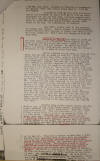
|
3.
25 July 1932.
Recent bandit activities and Guardia
offensive operations,
Capt. W. J.
Stone, El Gallo, to Col. L. L.
Leech, Bluefields, p. 3.
[From
"Guardia Nacional Newsletter No. 112,"
1-12 August 1932] " . . .
1:30 PM, July 18th. Arrived in vicinity
of headwaters of Apaunta creed (see
Marine Corps Map) at 7:00 PM and camped.
¶ Cleared at 5:00 AM July 19th and
arriving at the savannah at about 8:30
AM or 9:00 AM heard airplanes but did
not see them, although panels were laid
out. Arrived at Alimikengbang on the
Prinzapolca river at 11:00 PM after
going through several small towns on the
way. No information of bandits. ¶ July
20th, riders sent to the savannah to
inspect all trails. Patrol stayed in
Alimikangbang. Riders returned with
nothing to report and patrol cleared in
Mr. Leeming’s fruit boat for Tungla at
5:30 PM, July 20th. ¶ Arrived at Tungla
July 21st at 10:30 AM and upon gaining
no information there cleared for El
Gallo at 11:00 AM and arrived about
midway to El Gallo at 8:30 PM same day
and camped. As patrol was well worn, one
member being without shoes it was not
thought advisable to try to make El
Gallo that day. ¶ Patrol cleared for El
Gallo at 5:00 AM July 22nd, and arrived
El Gallo at 8:30 PM. After leaving
bandit trail Monday July 18th, nothing
had been learned of bandits, and upon
arriving El Gallo found the same case
prevalent, however four men who had been
pressed into service as porters reported
to me at 4:30 PM same date, stating that
the bandits had swung West after
marching in direction of “Balta Verde”
Monday July 18th, and that they the
porters had been set free on Wednesday
July 20th in the evening at the
Chavarrias farm which is located well up
the Sixicuas creek. Patrol of 6 men was
ordered to stand by and a boat was sent
for from La Cruz (the Fruit Companies
boats were all out picking up fruit).
Finally secured gasoline boat at about
12:00 PM. Information had been received
in the meantime that bandits had passed
through Palpunta at 3:00 PM that day.
Patrol of 16 men, Lieut Davis and self
cleared for Palpunta at 2:00 AM July
23rd, but due to motor trouble did not
arrive at Palpunta until about 11:30 AM.
Learned that bandits had passed through
there Thursday July 21st at 4:00 PM and
not Friday as we had been informed. As
bandits were now well on the way to San
Pedro del Norte with very little chance
of being overtaken, patrol returned to
El Gallo arriving at 4:30 PM July 23rd.
¶ Bandits were poorly armed; having one
Sub-machine gun, rifles of different
makes, shotguns (some muzzle leaders)
and little ammunition. Some were armed
only with machetes. They are believed to
be part of Pedron’s group which is said
to be somewhere north of the Tuma river.
Believed that they crossed the Rio
Grande well West of San Pedro del Norte
in the vicinity of Palsagua (USNC Fifth
Regiment Special Map) and making a large
detour to the South, struck the trail
coming from Chontales and came in by La
Brena, south of La Cruz and El Gallo. It
[?] . . . "
|
|
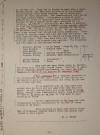
|
4.
25 July 1932.
Recent bandit activities and Guardia
offensive operations,
Capt. W. J.
Stone, El Gallo, to Col. L. L.
Leech, Bluefields, p. 4.
[From
"Guardia Nacional Newsletter No. 112,"
1-12 August 1932] " . . .
on the way out. They had no desire to
meet even a small Guardia force, but
were very vicious with the unarmed,
having killed seven known persons: two
of which were Jueces de Mesta Suplentes.
Two Commissariats were looted and many
private homes. Merchandise valued at
about $800.00 was taken or destroyed
from Santiago Schook at Morozan of which
$93.00 worth were recovered by the
Guardia. $1,500.00 in merchandise was
taken or destroyed from the Commissariat
of Edward Hislop besides $400.00 in
cash. Am unable to obtain an estimate of
the value of articles taken from private
homes. No livestock was taken except
that killed and eaten immediately. Their
system of carrying cargo and loot was
very efficient. Men when captured were
given the choice of being killed or
carrying cargo. When they were worn out,
they were set free and fresh ones
pressed into service. The following are
the names of the persons killed: ¶
Gregorio Abarca – at La Brena – Juez M.
Sup. – Nic., Juan Blandon – Castros Farm
– Juez M. Sup. – Nic, Juan Angula,
Castros Fram, Mozo – Nic., Teodoro
Averruz – Sixcaus Creek – Farmer – Nic.,
Clayton Hislop – Mandador
CDCo-Commissariat – Cayman’s (Bri Sub),
Albert Hislop – Contractor
CDCo-Commissariat – Cayman’s (Bri Sub),
Willie Hislop – Youth, Cayman’s (Bri
Sub) ¶ Many natives were taken along as
porters, but these will be later turned
loose. District is again quiet, although
people are leaving the river bag and
baggage, in spite of our efforts to
reassure them. ¶ This invasion was a
complete surprise as the individuals on
the trail South of here had no
opportunity to give us information; one
being killed and the others captured. ¶
It is expected that as they have once
raided this District and got away free
they will try again. As all
commissariats are being drawn in to El
Gallo, except a few commissariat boats,
they will have to come to El Gallo or La
Cruz if they wish to gain anything of
value. ¶ Civico organization at La Cruz
has been reorganized and an organization
of Civicos is being formed at El Gallo.
¶ Have enclosed in mail sack Marine
Corps map of Nicaragua showing bandit
route and places mentioned in this
report. ¶ W. J. STONE"
|
|
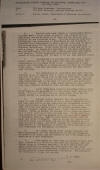
|
30 July
1932.
Recent Events, Department of Southern
Bluefields, Col.
L. L. Leech, Bluefields.
"1. Reports have been coming in
constantly during the past week a large
group of bandits had crossed the Rio
Rama about ten miles south of El Rama
and was working east parallel to the
Escondido River. Thinking possibly they
were heading for the Commissary at
Providence on the Escondido, I directed
Lieut Stephenson to send a patrol there
and to search the country south of the
River in the hope of getting some
definite information. Lieut Rourk failed
to find any trace of such a group, he
traced the movements of two well armed
men, who had been spying out the land,
asking questions and buying boat
paddles. Lieut Stephenson continued to
seek definite traces of this group, but
to date it is but just another rumor. ¶
2. Considering the possibility that such
a group really existed and that they
might have designs against the
commissaries on the Punta Gorda River, I
dispatched a small patrol from
Bluefields on a reconnaissance mission
up the Punta Gorda River. They left
yesterday by schooner and will return
next Saturday. ¶ 3. The inhabitants of
Bluefields were much excited Thursday
night by reports that a group of bandits
were approaching over the trail coming
into Bluefields from Rama, but their
fears were quieted. Civilian
intelligence agents had already been
dispatched well to the west of this
trail and other precautions taken. If
such a group really exists in this
section they have cleverly concealed
their location and actions. ¶ 4. Lieut
Stephenson reported yesterday that a
group of 40 bandits had appeared on the
Rio Siquia near junction Rio Danta. This
is very probably the group under Irias
who recently raided the commissaries on
the Rio Grande. ¶ 5. Captain Davies
reported that the inhabitants along the
new (south) section of the railroad,
Kipla District, had been very active in
all direction and discovered nothing.
Lieut Gaitan made a long patrol to
Laimus on the Coco River, then down the
river Kum thence across the Savanna to
Wawa Boom. Several formerly unknown
towns were found, but no traces of
bandits. While at Laimus, he learned
that a group had passed p the river
carrying a badly wounded man. It has
definitely been determined that the
bandits lost 2 killed and 6 wounded in
Peterson’s contact. Reports from Puerto
Cabezas indicate peace and quiet at
present. Captain Davies has
redistributed his force along the
railroad and now has 50 enlisted at both
Moss and Kipla farms. The Fruit Company
has concentrated their commissaries in
the vicinity of those two posts and has
a rolling commissary for the places in
between. ¶ 6. Mr. Baker, United Fruit
Company Manager, has made arrangements
for the commissaries on the Rio Grande
to be moved to El Gallo, and the places
on the river below to be supplied by a
boat commissary. ¶ 7. The people of
Bluefields and Puerto Cabezas were much
elated at the election of the Electoral
Mission, and the Sacasa group of
Liberals now feel they will have a fair
and square plebiscite on August 7th,
especially now that Major Marston has
arrived to personally supervise the
plebiscite here. He was accorded a most
enthusiastic reception. The political
pot continues to brew, but quietly. ¶ L.
L. LEECH"
|
|
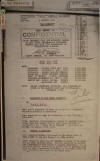
|
1 August
1932
Excerpts from
GN-2 Intelligence Report covering
the month of July.
[NOTE:
These excerpts constitute the sum total
of text devoted to the Atlantic Coast
region in this 30-page intelligence
report covering the entire country,
except for three longer reports by Col.
Leech, which are included on these
Atlantic Coast pages in chronological
sequence (July 1, 22, and 30). The image
to the left is the report's cover page
only.]
"
[p. 1]
. . . LOCATION OF
THE ENEMY ELEMENTS ¶
. . . (B) PEDRON ALTAMIRANO: 1st-
Reported having recrossed to the north
side of TUMA RIVER to his old hangout in
PEÑA BLANCA. ¶ 18th-
Reported with 200 RIO GRANDE vicinity of
EL GALLO and LA CRUZ, Eastern Area.
Further reported he sacked two
commissaries and killed 8 company
employees. It is believed Pedron, after
being driven out of NEPTUNE MINE area in
June, proceeded southwest to the TUMA
RIVER and then traveling via boats to
the EL GALLO AREA. . . . ¶
[p.
3] . . . (I)
SIMON GONZALES: ¶ 1st-
Reported with small group on COCO RIVER
in vicinity of SAKLIN. ¶
5th- Jefe of group of 60 which ambushed
Lieutenant Padilla and 3 guardias at
Vacarro Farm . . . ¶ 6th- In
contact with Lieutenants Henderson,
Kemp, Nuñoz and guardia patrol near
LECUS . . . ¶
[p.
5] . . . (R)
PERALTA [Gen. Ismael Peralta]: ¶
Fairly reliable information received
that PERALTA was killed during contact
near Neptune mines in June. . . .
¶ UNITS IN
CONTACT: ¶ . .
. 5 JULY – Lieutenant Padilla and patrol
had contact with group of 60 under Jefe
Simon Gonzalez at VACARRO FARM.
Bandit casualties unknown. Guardia
casualties, one killed and one wounded.
Mandador Cook of Vacarro killed and
commissary looted. ¶ 6 JULY
– Lieutenants Peterson, Kemp and Nuñoz
with guardia patrol of 25 enlisted had
contact 1130 with Simon Gonzales group,
which had looted Vacarro Farm Commissary
previous day, at a point one league east
of LECUS. Contact lasted one hour,
a running fight. Bandit casualties
three known killed, 3 known wounded.
Guardia casualties, none. Guardia
captured 1 rifle, 1 shotgun, 1 pistol,
three rifle grenades and recovered $200
worth of loot stolen from the
commissary. Dead bandit believed
to be a sub-jefe of Gonzales. Another
guardia patrol went in pursuit. ¶
[p.
6] . . . 17 JULY
– Lieutenant Stone and El Gallo patrol
of 11 enlisted had contact with bandit
group of 40, jefes Irias and Mairena
near PAN AMERICA. Bandit
casualties, two known killed. No
guardia casualties. Large amount
of loot, previously captured by the
bandits from one of the stores on the
Rio Grande, was recovered. ¶
. . .
[p. 12]
WEEKLY COMBAT
INTELLIGENCE SUMMARY FOR WEEK ENDING 4
JULY 1932 ¶
PRINCIPAL BANDIT
GROUPS REPORTED DURING WEEK:
¶ JUNE 28:- SIMEON GONZALEZ with
50 to 60 still reported operating on
COCO RIVER in vicinity of SAKLIN.
¶ PEDRON ALTAMIRANO and group,
reported at 100 or more, was driven
north of TUMA RIVER from vicinity of
CONSUELO. His raid to the South of
the river turned out to be a flat
failure. June 26 reported crossing
Tuma. ¶ . . . Eastern Area .
. . quiet during week. . . . ¶
[p. 14]
WEEKLY COMBAT
INTELLIGENCE SUMMARY FOR WEEK ENDING 11
JULY 1932 ¶
PRINCIPAL BANDIT
GROUPS REPORTED DURING WEEK: . .
. ¶ PEDRON believed to be
North of TUMA RIVER. ¶ . . .
UNITS IN CONTACT
DURING WEEK: ¶ JULY 5
– Lieut PADILLA and PUERTO CABEZAS
patrol in contact with SIMON GONZALEZ at
VACCARO FARM . . . ¶ JULY 7:
- Lieuts PETERSON, KEMP and NUÑEZ with
PUERTO CABEZAS patrol in contact with
SIMON GONZALEZ group one league east of
LECUS . . . ¶ . . . The
week, on the whole, has been quiet.
¶ . . .
[p.
16]
WEEKLY COMBAT
INTELLIGENCE SUMMARY FOR WEEK ENDING 18
JULY 1932 ¶ [nothing
in the Eastern Area] . . . Eastern Area
[has] been quiet. ¶
[p. 18]
WEEKLY COMBAT
INTELLIGENCE SUMMARY FOR WEEK ENDING 25
JULY 1932 ¶ . . .
UNITS IN CONTACT
DURING WEEK: ¶ JULY
17 – Lieut Stone and El Gallo patrol in
contact with bandit group of 40 under
IRIAS, MAIRENA and CHAVALIA [Chavarría]
near Pan American Central on Rio Grande,
Eastern Area. ¶ . . .
[p. 20]
OUR OPERATIONS:
¶ . . . Guardia patrol have been
unusually active this month as evidenced
by the twenty contacts had. Nueva
Segovia, and Jinotega still remain the
most active areas, although the Eastern
Area came in for its share. ¶
. . . "
|
|
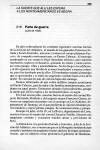
|
1 August
1932.
Parte de guerra,
Gen. Augusto C. Sandino, Cuartel
General del EDSNN, p. 1.
(Source:
A. C. Sandino, El
pensamiento vivo, v. 2, pp. 235)
"En julio sobresalieron los combates
siguientes: nuestras fuerzas de la
división del Atlántico, al mando de los
generales Francisco Estrada y Simón
González, atacaron y tomaron el campo
platanero Vaccaro, de compañía
norteamericana, en Puerto Cabezas.
Al enemigo acantonado en ese campo le
llegó inmediato refuerzo, pero nuestros
muchachos supieron rechazarlos, quitando
los trenes y moto-carros, así como
parque, rifles y ametralladoras.
Se dio fuego a los edificios, y al día
siguiente una flotilla de aviones
bombardeó a nuestra columna, pero fue
derribado uno de ellos. El
bombardeo orientó al enemigo que se
aproximaba y se trabó un sangriento
combate hasta cerca de la noche.
Se calculan en más de cien las bajas del
enemigo. ¶ Fuimos informados
de que veinte anfibios yanquis
acuatizaron en Puerto Cabezas, para
levantar a las familias norteamericanas,
residentes en aquel puerto.
Estimamos atinado el procedimiento,
porque la suerte que allí les espera a
los norteamericanos, es negra. ¶
. . . A última hora, los generales
Estrada y González, jefes de la división
del Atlántico, nos comunican que en la
Mosquitia hondureña han cruzado a
territorio nicaragüense fuertes núcleos
de tropas norteamericanas, que no
sabemos cómo permitiría el gobierno de
Honduras, . . . '
|
|
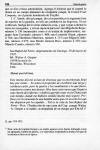
|
1 August
1932.
Parte de guerra,
Gen. Augusto C. Sandino, Cuartel
General del EDSNN, p. 2.
(Source:
A. C. Sandino, El pensamiento
vivo, v. 2, pp. 236)
" . . . que se dice celoso autonomista.
Agrega el informe que el cuartel lo
tienen en un campo platanero de compañía
yanqui, la United Fruit Company, en el
puerto hondureño de Trujillo. . . ."
[NOTE:
This undated document is assigned a date
of 1 August because it presumes to speak
of the month of July, and as we've seen
it could take weeks for news to reach
Sandino in the interior. In view
of the controversy on the date of the
letter to follow (August 2), a date of
August 1 or 2 makes the most sense.]
|
|

|
2 August
1932 (vs. 5 July 1932).
Carta de Gen.
Augusto C. Sandino, Cuartel
General del EDSNN, to Gen. Pedro
Altamirano, "La Chispa."
"Cuartel General del Ejército Defensor
de la Soberanía Nacional de Nicaragua.
¶ La Chispa, Agosto 2 de 1932.
¶ Señor, Primer Jefe de nuestra
Columna Expedicionaria N° 1. ¶
General Divisionario Pedro Altamirano
¶ Mi muy querido hermano: ¶
El General Estrada nos participa que el
5 de Julio próximo pasado, nuestras
fuerzas al mando del General Simón
González, “se posesionó” del campo y
Comisariato más fuerte de las compañías
yankees en Puerto Cabezas, el cual campo
le denominan Vaccaro. El General
González colocó estratégicamente las
fuerzas a su mando, penetrando él en
persona, con un grupo de sus muchachos,
al más famoso de los comisariatos, en
donde se aprovisionó de botas fuertes,
sombreros Stentson y finos trajes de
montar; cuando estuvieron listos en esa
forma, procedieron a levantar un
cargamento de mercaderías de la misma
clase y artículos de boca; todos
nuestros muchachos, cuando estuvieron
vestidos gogueramente, procedieron a
incendiar todas las mercaderías
almacenadas, el edificio del comisariato
y los barracones, pues toda la gente
había abandonado el lugar. [¶
Patria y Libertad ¶ A. C.
Sandino]"
Source:
A. C. Sandino, El pensamiento vivo, v.
2, pp. 232; on the date of this missive,
see the discussion under July 5, above.
|
|
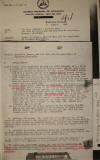
|
1.
9 August 1932.
Record of Events, Eastern Area and the
Department of Southern Bluefields,
Col. L. L. Leech,
Bluefields, to Jefe Director GN Managua,
p. 1.
"Subject: Record of Events, Eastern Area
and the Department of Southern
Bluefields. ¶ E
INTELLIGENCE. ¶ July 5 & 6
Bandit FRANCISCO ESTRADA and SIMON
GONZALES with a group estimated to
number sixty to eighty looted VACCARO
FARM commissary and killed the Mandador
at that place. Lieutenant PETERSON with
a Guardia patrol from PUERTO CABEZAS
gained contact with a detached group of
twenty while they were dividing their
loot completing dispersing them, killing
two and wounding six. Later
reports indicated that the bandit losses
were much greater than the known
casualties as reported by the Guardia.
(Detailed report has been submitted).
¶ July 17 Bandit Jefes IRIAS,
MAIRENA and CHAVARRIA, the latter a
native of LA CRUZ, with a group of fifty
to seventy raided commissaries at
MORAZAN FARM and PAN AMERICA, killed
seven people during the raid and made
their escape with the stores taken from
the commissary at PAN AMERICA.
Lieutenant STONE with a Guardia patrol
from EL GALLO made contact with the rear
guard of this group killing two but was
unable to gain contact with the main
body prior to their arrival on the river
where they took to boats and made their
escape to the west. (See letter
Area Commander re this group). ¶
July 26 A group of about forty was
reported in the vicinity of SANTA ANA on
the RIO RAMA moving in the direction of
PUNTA GORDA. Patrols failed to
confirm the reports and the district
continues quiet. (Report has been
submitted). ¶ 2. Military
situation: The condition of trails and
the terrain generally will prohibit the
movements of any large group during
August. Raids by small groups on
isolated farms are expected and being
guarded against. These groups
will, it is believed, avoid any contact
with the Guardia. ¶ 3.
Economic Situation: Continues Good.
The cutting and shipment of fruit during
July was not up to the standards of
previous months due to a decreased
demand for fruit in the United States.
¶ 4. Sanitary Conditions:
Satisfactory. The Guardia
commander at WUANI reports that Malaria
is very prevalent in that vicinity.
¶ 5. Political Situation:
Quiet. The news of the nomination
of SACASA was enthusiastically received
by all classes of people on the coast
where he is very popular and has built
up a powerful political machine. . . . "
|
|
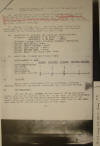
|
2.
9 August 1932.
Record of Events, Eastern Area and the
Department of Southern Bluefields,
Col. L. L. Leech,
Bluefields, to Jefe Director GN Managua,
p. 2.
". . . 6. No friction has been reported
between the Guardia and the civil
population except that the people on the
RIO GRANDE have not been over friendly
towards the Guardia since the 17th.
This attitude is no doubt due to their
fear of another bandit raid in that
territory. The press continues
friendly. ¶ 7. Weather:
Steady, and at times heavy rains during
entire month. River and coastwise
transportation scheduled more regular.
Visibility for air reconnaissance was
good to bad. ¶ 8. Condition
of telephone and telegraph
communications: Telephone – BLUEFIELDS
to EL BLUFF – Fair. BLUEFIELDS TO
EL RAMA – GOOD. Civilian Tropical
Radio Telegraph Company – Excellent.
Guardia BLUEFIELDS – Good. Guardia
PUERTO CABEZAS – Good. Guardia
CABO GRACIAS – Fair. Guardia
NEPTUNE MINE – Good. Guardia WUANI
– Not heard since 20th. ¶ 9.
Conditions of Roads and Trails – Bad.
¶ F CONFISCATION OF ARMS. ¶
Confiscated during the month –
Serviceable – 6 SHOTGUNS, 1 PISTOL.
Confiscated during the month –
Unserviceable – None. Previously
reported – 8 RIFLES, 6 SHOTGUNS, 17
PISTOLS, 0 CUTTING WEAPONS. (TOTAL) 8
RIFLES, 12 SHOTGUNS, 18 PISTOLS, 0
CUTTING WEAPONS. ¶ G TRAINING
¶ Except where interfered with by
patrolling, training schedules have been
maintained. Discipline has been
satisfactory. ¶ H
MISCELLANEOUS ¶ On July 17,
Mr. FAUSSIG, General Manager of the
Mercantile Stores owned by the Guaranty
Trust Co., of New York, arrived
BLUEFIELDS for an inspection of the
Bluefields Mercantile Company one of the
chain stores. Mr. Faussig stated
that business conditions on the coast
were much better than he had expected to
find them. . . ."
|
|
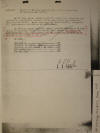
|
3.
9 August 1932.
Record of Events, Eastern Area and the
Department of Southern Bluefields,
Col. L. L. Leech,
Bluefields, to Jefe Director GN Managua,
p. 3.
". . . On 27 July, Major SCHMIDT,
Guardia Paymaster, inspected and studied
the disturbing accounts of the
Department Quartermaster, Southern
Bluefields. Major REA, Guardia
Quartermaster, inspected all
quartermaster activities in BLUEFIELDS.
¶ On 29 July, Major MARSTON,
USMC., arrived BLUEFIELDS to take charge
of electoral activities on the East
Coast. The people of BLUEFIELDS
were very enthusiastic in the reception
accorded Major MARSTON on his return to
the coast. ¶ I CIVICOS.
BLUEFIELDS 74, DISTRICT OF SEQUIA, RAMA
13, DISTRICT OF RIO GRANDE – LA CRUZ 10,
RIO GRANDE BAR 12, NEPTUNE MINE 95
¶ L. L. LEECH"
|
|
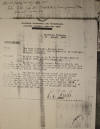
|
17 August
1932.
Further Report on Killing of Mr. H. L.
Cooke at Vacarro Farm on July 5, 1932,
Col. L. L. Leech,
Bluefields, to Jefe Director GN Managua.
"1.
Since the raid on Vaccaro Farm on July
2, and the death of Mr. Cooke,
information has reached this office that
Mr. Cooke was killed by and at the
instigation of a laborer whom he had
fired and driven off his farm. ¶
The discharged laborer sought out and
guided the bandits to Vaccaro. It
has been reported that Mr. Cooke fled
and drove the laborer away in order to
possess his (the laborers) young native
woman and that she was living with Cooke
at the time of the raid. This fact
is commonly talked over by the people of
the section, but as to its voracity, I
do not know. It is further said
that the discharged laborer was the one
who mutilated the body. ¶ L.
L. LEECH"
|
|

|
23 August
1932
Further Report on Bandit Raid on Rio
Grande River July 22nd,
Col. L. L. Leech,
Bluefields. "1.
It has been learned that during the
retreat of the bandits after their raid
on the commissaries on the Rio Grande
River July 22nd, that they killed the
following people all Nicaraguans:
¶ Four Gutierrez brothers, ages
15-18-22, and 33 years, and one Tomas
Cruz, age 46 years at Queppi on the Rio
Tuma on or about July 25th. Also
one Mario Sanchez was killed above the
Queppi on the river. ¶ 2. It
is reported that the Gutierrez brothers
were killed because they had returned
some mules left in their charge by
Pedron in February 1931, to their
rightful owners in Cuicuina. When
they were called for in July and their
action learned, they were put to death.
No reasons have been learned for the
killing of the other two. ¶
3. The above killings were witnessed by
people captured during the raid and who
were forced to go with the bandits until
well above Queppi where they were
released and on their return to El Gallo
reported the above. ¶
(signed) L. L. LEECH"
|
|
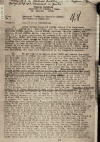
|
31 August
1932.
Report of My Commission,
Sgt. Cresencio
Chamorro, GN #1652, Rama,
District of Siquia, to District
Commander.
"1. After having
received verbal orders from Lieutenant
Romero, I cleared on a commission, with
the following enlisted: Fletes, Mercedes
#4898, Zepeda, Julian #2259; Zeledon,
Joaquin #4818, and Garcia, Manuel #4964.
Having requested from Mr. Carlos Fornos
a motorboat to go on said commission.
We cleared from here at 1830 on 27th of
August, 1932. Not very long after
having begun our march, the motor
wouldn’t work though we tried our best.
It was about 1930, and knowing that the
commission was urgent, I requested from
Mr. Alfonso Webster, to loan us one of
his tugboat to take us to El Recreo.
He loaned it to us with pleasure,
clearing this place about 2000, taking
along with us beside the enlisted men
above mentioned, two mechanics and one
guide, who came from Bluefields on the
Company’s account. ¶ 2. We
arrived at El Recreo about 2130 and
passed the night here. We cleared
at 5000 the next morning in a paddle
boat, hired from the Chinaman Jose, that
lives here, we traveled that whole day
until we reached a placed call El
Sajino, and slept here. Between El
Sajino and El Recreo at a place called
Buena Vista, the planes located us, and
we landed and laid out the panels U X
and an arrow to indicate the direction
we were taking. When the planes
saw us, they came over where we were and
dropped a letter that said “Continue
your march always ahead until you arrive
a Chilamate. If you can’t see us,
light a fire that will produce plenty
smoke. When you hear planes and
you need provisions, lay out panels F F
– Col. LEECH”. After this, we laid
out the panels O K, and they went away.
We continued our march until we arrived
at a place called “El Sajino” where we
slept. We left the following
morning about 6000 on the same Rio Mico,
and had to pole our boat up the river.
We arrived at about 1130 at the House of
the Herreras, not very far from Muelle
de los Bueyes, when we were located by
the planes, and which dropped the
following letter. “Sergeant
Chamorro return to El Rama. Lieutenant
B. H. below the Rio Chilamate”. My
reply to them was same as before.
At the house of the Herreras, I learnt
from the owner of the house that at
Muelle de los Bueyes, the guardia
motorman, Rafael Mayorga and his second
were there. I went to this place
which is about 500 meters in distance,
leaving all the others who were with me
to prepare the food. According to
the information which I received from
Mr. Mayorga, that Lieutenant Stephenson
was enroute from Chilamate going to El
Garrobo; this information was given to
Mr. Mayorga by a person who was coming
from Chontales. After I had this
information and with the orders which I
had already received, I decided to go
ahead. From this place I sent back Rasa
Julian Zepeda to advise Lieutenant
Romero of the information I had
obtained. I went in the direction
of Chilamate with my commission and came
upon Corporal Valle and Rasos Calderon,
Alejandra, Ebanks, Ferrell. I
interrogated the corporal as to what was
he doing there, and he answered me.
Sergeant, I have orders from Lieutenant
Stephenson not to move from here, until
he returns or until I receive a message
from him. We cleared this place
the following day for Rama on the same
river, leaving Corporal Valle at this
point. On my return, and passing
through Muelle de los Bueyes I had to
stop to hire a boat, when Corporal
Valle, reached us there and we both went
to Rama. Corporal Valle was coming
in a borrowed boat belong to the
Highways; and I and my guardias were
coming in the boat we hired.
Corporal Valle went ahead, and in and of
the currents named “Cedro Macho” the
boat turned up, and all the Guardia
equipment, . . . [end]"
|
|
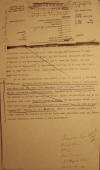
|
31 August
1932.
Excerpt from Draft Inspection Report,
9th Company, Puerto Cabezas,
no author
indicated (apparently a rough
draft).
|
|
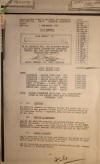
|
1 September
1932.
Excerpts from the
GN-2 Report Covering the Month of
August 1932.
[NOTE:
These excerpts constitute the sum total
of text devoted to the Atlantic Coast
region in this 33-page intelligence
report covering the entire country,
except for one report by Col. Leech,
included here in chronological sequence
(August 23). The image to the left is
the report's cover page only.]
"
[p. 1]
. . . [LOCATION
OF THE ENEMY ELEMENTS.] ¶
. . .
[p. 4]
(N) SIMON GONZALEZ ¶ Reports
continue to be received that Simon
Gonzalez has died of wounds as a result
of contact with PUERTO CABEZAS patrol in
July. ¶ [NOTE: Of the
17 EDSN chieftains surveyed in the first
4 pages, this is the only mention of
anything having to do with the Eastern
Area] . . .
UNITS IN CONTACT: ¶ .
. . [p.
5] 19 Aug:
Enlisted patrol with Civicos from Santo
Tomas and San Pedro, Dept. of Chontales,
had contact with bandit group which
raided Pueblo Viejo on August 18 at
point three leagues southeast of SANTO
DOMINGO 352-208. One known bandit
killed. No guardia casualties.
One Civico wounded. Bandits were
scattered. Captured one rifle, one
revolver and practically all of the loot
taken from Pueblo Viejo. ¶ .
. .
[p. 6]
20 Aug: Lieutenant Tercero and Chontales
patrol had contact with same group with
which contact was had on the 19th near
same locality, (southeast of SANTO
DOMINGO 352-208). Bandit
casualties two killed. No guardia
casualties. Patrol captured one
horse and small amount of ammunition.
[NOTE: This is far from the Coast and
outside the Eastern Area, in a military
zone designated as the “Southern
Departments,” and this “bandit” group
was probably not affiliated with the
EDSN. These reports are included here as
the only notable military activity
approximate to the Atlantic Coast
region] ¶ . . .
ENEMY STRENGTH
AND MOVEMENTS: [NOTE:
There are 46 individual snippets of
information compiled in this section;
only one concerns the Atlantic Coast;
another one concerns the attack in
Chontales, viz.] ¶ . .
.
[p. 7] 3
Aug: Large group of 200 reported between
Waspook and Kisalaya on Rio Coco . . .
¶
[p. 8] 18 Aug:
Reported bandit group of 20 raided and
robbed the town of Pueblo Viejo, six
leagues northeast of ACOYAPA, Dept
Chontales. ¶ . . .
[p.
12] ESTIMATE:
¶ Nothing of importance in the way
of bandit activity is predicted for the
Eastern Area in the immediate future.
¶ . . . [p. 33]
CONSOLIDATED
CONTACTS FOR THE MONTH OF AUGUST 1932:
¶ [NOTE: Of 20 military
contacts, none were in the Eastern Area]
"
|
|
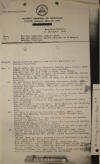
|
1.
5 September 1932.
Record of Events, Eastern Area and the
Department of Southern Bluefields,
Col. L. L. Leech,
Bluefields, to Jefe Director GN Managua,
p. 1.
|
|
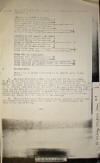
|
2.
5 September 1932.
Record of Events, Eastern Area and the
Department of Southern Bluefields,
Col. L. L. Leech,
Bluefields, to Jefe Director GN Managua,
p. 2.
|
|
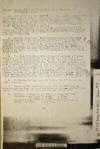
|
3.
5 September 1932.
Record of Events, Eastern Area and the
Department of Southern Bluefields,
Col. L. L. Leech,
Bluefields, to Jefe Director GN Managua,
p. 3.
|
|
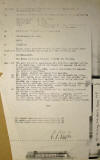
|
4.
5 September 1932.
Record of Events, Eastern Area and the
Department of Southern Bluefields,
Col. L. L. Leech,
Bluefields, to Jefe Director GN Managua,
p. 4.
|
|
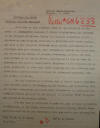
|
1.
7 September 1932.
Circular No. 32-16, Tropical Division
Managers, from A.
A. Pallan, United Fruit Company,
Boston MA, p. 1.
"From time
to time evidence comes to our attention
of the desire of communistic elements to
foster trouble among the laborers of the
Tropical Divisions. Thanks to a
general reluctance of the laborers in
most tropical countries to affiliate
with these people, and also to the
energetic attitude which certain
governments of the Caribbean area have
adopted, such attempts to disrupt our
labor have not met with any measure of
success. Communism, however, has
made some strides in the United States,
thriving as it does in time of
depression and general unemployment.
Vigilance at the tropical end is still
called for in order that these elements,
who are evidently supplied with a
certain amount of money for propaganda
purposes, will not obtain a foothold.
¶ In this connection, I attach
copy of report from a confidential
operator made to the Company in New
Orleans, and indicating that two typical
communistic agitators named Fitzsimmons
and Hardy are already in Central America
for the purpose of spreading “red”
doctrine and generally encouraging
unrest. ¶ You may find it
advisable to pass the gist of this
information unofficially, to the proper
authorities of your country.
Should these agitators show up in your
Division I will appreciate your advising
me. ¶ /s/ A. A. Pallan
¶ Copy to Mr. C. B. Ellis, ¶
Enclosure. . . ."
|
|
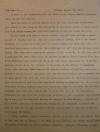
|
2.
7 September 1932.
Circular No. 32-16, Tropical Division
Managers, from A.
A. Pallan, United Fruit Company,
Boston MA, p. 2.
[Report of "#38," spy & informant among
Bluefields Communists, Mon., 29 Aug.
1932, p. 1.] "Monday,
August 29, 1932. ¶ #38
Reports - ¶ I went to the
Communist Hall and found Frank James,
Bayers, Weakman, Rice, Robert and
Shultz. ¶ Shortly after I
arrived Shultz left the hall with some
literature and stated he was going in
the direction of the water front to make
contacts with longshoremen and also with
sailors aboard the ships in port.
¶ I conversed with Bayers and he
stated they had been getting a great
number of longshoreman to join the
organization lately; that a man named
Lawrence was coming from New York to
replace Davis and that two other
organizers were coming with him; that
McCarthy had left for New England last
night; that they had a very good meeting
of the I.L.D., in the hall about a week
ago and there were about 30 members
present; that a doctor from the Toure
Infirmary had joined the I.L.D.; that
there was going to be another meeting of
the I.L.D., tonight at 8’oclock in the
office of Bernstein Bros., for dealers.,
#209 Decatur St. Sayers further stated
they soon expected a revolutionary
outbreak; that the New York Office had
requested him to look around the city
for arms and ammunition easy to seize in
due time; that in answer he had reported
the State Armory on Magazine St., as a
place with many rifles, machine guns and
ammunition easy to get when the trouble
started; that Rice was a World War
Veteran, had been in the Washington
struggle, and was here now organizing
veterans of the locality; that yesterday
a man from the New York office had
stopped in New Orleans a few hours on a
secret mission and immediately departed.
He declined to state the name of this
man or the mission with the excuse that
it was only a matter concerning the
Party. ¶ Later Weakman,
negro organizer, called me to one side
and stated that he had been put in
charge of the West Indies Division and
wanted to go give him names of people in
Santo Domingo, Kingston, Jamaica,
Trinidad, George- . . . "
|
|
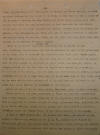
|
3.
7 September 1932.
Circular No. 32-16, Tropical Division
Managers, from A.
A. Pallan, United Fruit Company,
Boston MA, p. 3.
[Report of "#38," spy & informant among
Bluefields Communists, Mon., 29 Aug.
1932, p. 2.] " . .
. -town, British Guinea and other ports
in Central and South America, as well as
other information that would be of value
to him; that it was an issue of the
program to develop the West Indies and
South America along with this country
and under the same principles, so that
whenever the revolution starts here, in
the event soldiers are needed, workers
could be brought from there; that
Fitzsimmons and Hardy had gone to
Central America to educate the workers
along the Atlantic Coast and the last
time they wrote they were already on the
Mexican Guatemala border. ¶
Later I cultivated him along his local
activities and he stated he had been
organizing longshoremen and negroes
employed in other large industries of
the city; that he believed the
longshoremen would soon strike again;
that the handicap at present was that
they had no “job control” any longer;
that in every speech he delivered in
negro homes, churches and lodges, he
always pointed out the fact that the
capitalists wanted the negroes to be
inferior to the whites, work for less
than the whites and live in a
superstitious mood so as to keep them
down and he advised them to keep their
head up the same as the white workers
and to be rebellious and militant in all
cases that would concern the struggle of
the workers. ¶ Hobert and
Rice left the hall stating they were
going to make contacts. ¶
James stated he had been organizing in
Texas and had been transferred back to
New Orleans to fill vacancies of the
organizers that left recently; that he
expected to contact workers of large
industries here, including the N. O.
Public Service, mostly as the seamen
were well covered at present; that he
might also assist Soler in the
reorganization of the I.L.D. ¶
I went to #207 Bourbon St., and talked
with Soler, who stated he expected to
have a big meeting of the I.L.D.,
tonight at 8 o’clock in Bernstein’s
office; that he had been very active
lately getting new members and calling
on the old members; that now he was
trying to raise sufficient . . . "
|
|
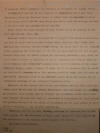
|
4.
7 September 1932.
Circular No. 32-16, Tropical Division
Managers, from A.
A. Pallan, United Fruit Company,
Boston MA, p. 4.
[Report of "#38," spy & informant among
Bluefields Communists, Mon., 29 Aug.
1932, p. 3.] " . .
. to purchase office equipment and
supplies as to reopen the I.L.D. office.
¶ At 7:45 PM I arrived in the
vicinity of Bernstein’s store and found
Bernstein, Soler and Lamarque there.
I joined them and remained in front of
the store until [?]:30 PM, when Soler
decided to call the meeting off due to
the fact that the members did not
arrive. ¶ Soler stated he
would arrange to hold another I.L.D.
meeting in the hall next Sunday, Sept.
4th. ¶ Lamarque stated that
he had received a telegram from Lawrence
announcing that he would arrive in New
Orleans early tomorrow, Aug. 30th; that
Lawrence had recently visited Soviet
Russia and while there he had obtained
books, pictures and literature of all
the new developments and had versed
himself well with Soviet system and
beginning Wednesday, Aug. 31st, he would
start a series of speeches on all he
witnessed and learned while in Soviet
Russia; that Wednesday’s speech would be
at a meeting of the young Communist
League, where a number of women are to
be present; that he would not know until
tomorrow where that meeting would be
held; that the rest of Lawrence’s
lectures would be in churches, union
halls and lodges and in occasional
meetings of the different Communist
units. ¶ Lamarque further
stated that he and his brother had all
they could be taking care of the sale of
radical literature; that his sales were
showing an increase every month; that he
thought the revolution would start soon
now, because that was the topic of
conversation everywhere and this thought
was growing stronger in the minds of the
people as the only medium of relief and
a solution to the present depression.
¶ Bernstein did not do much
talking, although he remarked that he
had been helping the revolutionary
movement right along and would support
the revolution to the fullest extent
whenever it started. ¶ At 9
PM I discontinued."
|
|
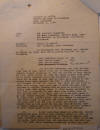
|
1.
12 September 1932.
Report of patrol, District Commander
Capt. Theodore M.
Stephenson, Rama, District of
Siquia, to Col. L. L. Leech, Bluefields,
p. 1.
"1. In accordance
with reference (a), cleared on August
22, 1932, with the following enclosed
from Rio Chilamate: Cabo Francisco
Valle, No. 939, Raso Carlos Franco 3512,
Raso Adolfo Gomez 2443,
Raso Alejandro
Calderon [NOTE:
name crossed out with handwritten note:
“Leave this man out.”] ¶
2. 1600 arrived Guadalupe, and with
information that El Sapo rapids could
not be navigated after dark, camped.
Cleared Guadalupe at 0400 and arrived El
Sapo Rapids at 0600. Heavy floods on
river and banks covered with water up to
trees. Outboard motor-man informed
me that rapids could not be made in this
type of boat; as a return to Guadalupe
would have entailed the loss of some
five hours, I took command of boat and
ordered Cabo Valle and one other ashore
with strong line, pull boat to shore and
made some progress up rapids, holding
boat as much as possible to partially
dead water among trees. It often
became necessary to fill boat to
gunwales to pass under some fallen tree,
at 1030 arrived head of El Sapo, with
but a few more yards to go boat became
swamped, it became necessary to cross
rapids to other side, started motor, and
took chance of making other side with
the loss of about one hundred yards.
Pushed boat up with poles and pulling
with petruding [protruding] limbs of
trees, finally came out to smooth water.
Arrived Opendalo at 1300, where plane
picked us up and dropped message.
¶ 3. After collecting boats and
paddlers, cleared Opendalo at 1500.
Arrived head Opendalo Rapids at 1700, at
1900 arrive Grand Gayo, impossible to
travel at nights, made camp.
Cleared at 0500 for El Diablo, at 0700,
while proceeding up rapids, boat struck
rock, and capsized. All paddlers
jumped over side. While swimming
attempting to make the river . . . "
|
|
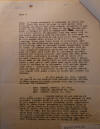
|
2.
12 September 1932.
Report of patrol, District Commander
Capt. Theodore M.
Stephenson, Rama, District of
Siquia, to Col. L. L. Leech, Bluefields,
p. 2.
" . . . bank, it
became necessary to disengage my pistol
and belt, shoes and shirt in order to
save myself from downing. My
patrol had prior orders, on advice of
paddlers, to cut their way to head of
rapids through jungles. I thought
it best to remain with boat.
Through the utmost efforts of paddlers,
boat was saved from total wreck, patched
a hole on its side. At 0900 made
head of rapids. Arrived at the
foot of El Diablo Rapids at 1100 August
24th. Picked up by plane in an
open clearing. Plane made three
drops of provisions. Left patrol
in the direction for what I took to be a
southerly direction, when it returned
flying dangerously close to trees.
It crashed about one hundred yards from
patrol. Organized searching party
and cut way through jungles to crash.
Gave first aid to Lieutenant Rutledge,
removed all movable articles from plane
and made haste down river.
Lieutenant Rutledge died at about 1300.
At 1400 picked up by plane, who informed
that I should be at Rama on the twenty
fifth. At 1500 arrived La Tigra,
where I sent patrol back under Cabo
Valle with instructions to continue on
to Chilamate. 1700 arrived
Guadalupe where I transferred bodies to
motor boat. 0930 arrived Rama and
transferred bodies to quartel ashore.
1100 August 25th plan picked up bodies
and cleared for Managua. ¶
4. At 1400 August 25, 1932, cleared for
Muelle de Los Buellos [Muelle de los
Bueyes] with outboard motor. Arrived at
1000, August 26, 1932. Cleared
with the following enlisted for
Chilamate: Raso EBANKS, Ferrell No.
2416, Raso PADILLA, Espinales No. 2322,
Raso FRANCO, Carlos, No. 3512 ¶
5. Cleared Muelle de Los Buellos [Muelle
de los Bueyes] at 1800. Plane
picked up patrol at 1500 with message to
keep on going, stranded aviators were at
a point due South. At 0600 August 27,
arrived Chilamate river. Organized
a party of three boats. Proceeded
up Chilamate river at 0800. Polled boats
to a point about thirty miles from mouth
of river, one boat with provisions
capsized with the loss of same.
Men and paddlers were hungry, camped
while some dozen iguanas were shot, and
roasted them over a fire.
Proceeded down river, firing occasional
shots to attract attention of aviators
providing they were in that vicinity.
Camped on bank of stream at 1800. . . .
"
|
|
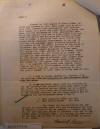
|
3.
12 September 1932.
Report of patrol, District Commander
Capt. Theodore M.
Stephenson, Rama, District of
Siquia, to Col. L. L. Leech, Bluefields,
p. 3.
" . . . Cleared
at 0500 August 28 down stream.
Arrived Los Iguanas at 0800. Made
plane pick up at about 0900.
Cleared with information that aviators
were camped at a point ten miles below
Chilamate village. Arrived
Chilamate at 1100, encountered Cabo
Valle and patrol. Told him to join
forces with Sgt. Chamorro’s patrol and
act upon any further information by
plane. I proceeded down river
firing occasional shots, stopping
occasionally to cut way to reported old
mahogany camps. Aviators appeared
to be nowhere on the Chilamate.
Arrived at the mouth of Chilamate, and
proposed the searching of Rio Rama up
stream. 0800 camped alongside of
river bank. 0500 August 29, 1932,
cleared for up stream, firing occasional
shots. At 0900 picked up by plane,
who informed me that aviators were one
half mile away. At 0930 arrived
camp of aviators. 1030 cleared with
aviators down river. 0600 camped
along river bank, and cleared at 0500
August 30th for down river. At
0800 boat capsized while going down
rapids, resulting in the loss of three
guardia rifles and other miscellaneous
supplies. Arrived Guadalupe at
1400 and patrol changed to motor boat,
arriving Rama at 1600. ¶ 5.
I wish to highly commend all members of
my two patrols,
with the exception of Raso Alexandro
Calderon, No. 3472. ¶
6. While the above report does not
entirely cover the hardships and
primitive conditions under which men
lived, the patrols carried themselves in
a manner indicating high efficiency and
determination to get to the stranded
aviators. The following members
are recommended for the Nicaraguan medal
of Merit: Cabo Francisco Valle No. 939,
Raso Carlos Franco No. 3512. ¶
The former for his initiative and
leadership in overcoming great odds and
endangering his life in rapids in order
to set an example to boatmen. The
later for the excellent manner he
rendered first aid to the former Lieut.
Rutledge, USMC., not leaving his side
until he had died. He did much to
hold up the morale of patrol at all
times. ¶ Theodore M.
Stephenson"
|
|
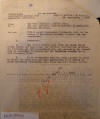
|
4.
12 September 1932.
Report of patrol, District Commander
Capt. Theodore M.
Stephenson, Rama, District of
Siquia, to Col. L. L. Leech, Bluefields,
p. 4.
1st Endorsement,
Col. Leech, 16 Sept. "1.
Forwarded. ¶ 2. The report
clearly sets forth the known danger of
the rapids and high water, the terrific
difficulties involved, the fortitude and
determination of all, and especially the
leadership of Lieutenant Stephenson and
the inspiring example set by Cabo
Francisco Valle. ¶ 3. It is
recommended that the entire patrol be
cited in Orders for their acts and that
appropriate medal awards to given
Lieutenant Stephenson, Cabo Valle and
Raso Francos, Carlos. ¶ L.
L. LEECH"
|
|
|
|
|
PREVIOUS
NEXT |
|
|
|
|
|
|
|

